#these are pretty much the main songs lately that ive been listening to on repeat
Explore tagged Tumblr posts
Text
Aww shucksness thank you for the tag @imaginaricide ! :'S So looks like the thingy here is to post 10 songs that you've been jammin' out to lately.. (Preemptively warning oldies music is my fav so uhh they compose half of the list here the first five to be exact just wanted to let yall know I've had to hold back from listing 10 Beach Boys songs because i love oldies so much) 1. Don't Worry Baby - The Beach Boys 2. Rag Doll - Frankie Valli and the Four Seasons 3. Duke of Earl - Gene Chandler 4. In the Still of the Night - The Five Satins 5. Rubber Ball - Bobby Vee 6. Lovely Day - Bill Withers 7. One Fine Day - The Offspring 8. Love Together - Nona Reeves 9. Kitty History - Trevor Moore 10. Movement - The Pillows I'm atrocious at taggin'...but @sleepysak @trashunlimited @zreblogs @that-fangurl-tho @nightshade1994 @little-alien-alien @choco--cheshire @garbagebucket @litaisfearless because yall are really cool and awesome and amazing followers 💖
#drapa#tagged in#you all really do seem pretty cool#itd be even cooler to see what music yall like too#im terrible at trying to make conversation i just think you all are neat :'S#anyways tada see my questionable music taste#these are pretty much the main songs lately that ive been listening to on repeat#Rag Doll especially. ive known of it for a week and ive played it hundreds of times already
3 notes
·
View notes
Text
i was tagged forever ago by @jaanoo to do this “get to know me better/20 questions” tag ty for tagging me :D
♡ what do you prefer to be called name-wises?
fiona is my name but i like being called fi and any other nicknames yall wna call me wld be cute i love being called nicknames
♡ when is your birthday?
my birthday is jan 22nd
♡ where do you live?
i live in texas :) but i go to school out of state
♡ three things you’re doing right now?
um answering these q’s, listening to skip skip by purple kiss and procrastinating a few very easy hw assignments :p
♡ four fandoms that have piqued your interest right now?
uhhhh none rly unless kpop counts i havent rly watched anything new lately
♡ how is the pandemic treating you?
um its been up and down really thankfully only one of my family members have had covid but he is alright now. ive done a lot of thinking and reflecting on myself and i get rly sad sometimes about everything thats been happening but overall i think its been just ok which i am grateful for.
♡ song you can’t stop listening to right now?
staycs new mini ugh its been on repeat since monday i cant get enough also ive been listening to a lot of cherry bullet as well especially the cherry rush album.
♡ recommend a movie
well i am blanking on all the movies ive seen rn but ill always recommend the handmaiden :)
♡ how old are you?
19 :D cant believe im turning 20 in a couple months it feels strange
♡ school, university, occupation, other?
i am a junior in college rn, a communications design major :)
♡ do you prefer hot or cold?
cold c:
♡ name one fact others may not know about you.
i have a twin sister @/suminie ive been telling my online friends this and theyve been freaking out abt it lsdjkfsl its so funny
♡ are you shy?
yeah :( in person im pretty awkward and i hate it, but online im way more outgoing for obvious reasons
♡ do you have any preferred pronouns?
she/her :D
♡ any pet peeves?
ppl that talk over other ppl or ppl that dont make a conscious effort to make you feel like they are listening to you :/ that shit makes me feel like never talking again </3
♡ what’s your favourite “dere” type?
uh idk :p
♡ rate your life 1-10. 1 being really crappy and 10 being the best you could ever be.
probably a 4 idk i dont do much and im really trying to change that about myself and nothing rly super amazing is happening in my life rn so yeah
♡ what’s your main blog?
this one :)
♡ list your side blogs and what they’re used for.
i have one sideblog @/dreamirene its just like an inspo dump blog but i havent used it in a while
♡ is there anything you think people need to know about you before becoming friends with you?
uhh i say a lot of cringy things ironically i dnt know if it translates well but when i start saying something i usually cant stop for a while so ur just gna have to bear w me LOL but yeah also i like to be affectionate <3
ill tag @pegbot @suminie @eyelessmp3 @8126 @frappujinno @kangseulgie @snsdpop @yukika @korimi4 @moatual @cherryhub and anyone else tht wld wna do it idk <3
12 notes
·
View notes
Text
oh shit i was going to liveblog mmmm 2005 wasn't i? it's getting a bit late but i think ive got time even if my fingers are getting a lil antsy pantsy jittery due to outside influence but i doubt i'll be any more incomprehensible than i normally am
-that's a noticeable difference in the intro harmonies here. more zubin or rob or something
-everything else seems mostly the same
-correction the difference is a whole lot more joe. just in general. rob's "it's nothing" was super quiet
-so are these wavery harmonies that get me goin every time
-main vocals seem mostly the same in every way. i am hearing a noticeable difference in general audio quality but that might just be the upload
-oh that megaphone thing is really cool. i forget how prevalent it was in the 2008 ver but it being only in one ear has to be unique to this. i wonder why they didnt do that for the re-release
-that "aaaah" has a very different sound. pretty clearly an isolated thing. and maybe this is just me coming off of a bunch of live performances but the background aahs in general seem a little quieter
-rob's vocals for glass eyes are mixed differently i can just tell & there was some sort of swish-slide sfx there that i dont remember from the rerelease it's cool sliding through my headphones like that. hang on are my earbuds in the right way
-aye they are alright continuing with the song
-piano sounds different, are we missing an upper harmony? in the vocals yes the harmonies are different but in the piano too definitely
-the nonsense is louder in many regards. no harmonies for let us sing to start? what's up with that
-i want to hear the zubin. if i had heard this the first time through i'd be able to understand rob's lyrics way way better
-bird outro goes longer and oh would you listen to that it's greener time. mixing's different and hey these guitars are hopping between my earbuds that's cool
-acoustic guitar? is that there in the 2008 ver? at least not as strong as it is here
-not a lot of differences beyond the mixing & the stereo audio. oh that synth riff's different actually nevermind
-something's slightly off about rob's vocals. maybe it's the fact that the harmonies are only coming in here at the chorus, it's probably just the quality/mixing, but still. he's also hanging out mostly in my left ear for some reason.
-mixing is really bringing out this guitar melody and for some reason that big climactic riff is acoustic for some reason what's up with that
-like 90% of this commentary is currently & will continue to be "hey this is slightly different what's up with that" unless i start hearing some really huge differences sorry bout that. not sorry but i'm saying it anyway you cannot stop me
-anyway i like the zubin harmonies here
-seriously way more acoustic guitar harmony in this solo it's odd. i understand the change but also this does have an appeal i can't say i dislike it
-outro's sounding different. long & feedback i do not like please.
-not sure if that long pause's supposed to be there or if it's the youtube format but it's. something
-oh welcome to tally hall. this one's gotta be different. i think one or two sounds here in the intro is different & way more stereo audio what's up with that. why didn't they leave all the headphone fukcery in it's cool
-i think this intro's longer or there's just more carnival noises for longer
-once again! so much earphone messing about i love it shouldve been left in. although if i may be a critic making it a bit more balanced wouldve been better
-oh it's just a bass riff & not a guitar riff. that's interesting. very different sound
-heterophonic still? i thought it was homophonic or something like that at some point. huh
-i'm pretty sure the only song from this album ive heard all the way through is banana man just because this is the one used for the music video
-high toy piano bit & wooshy sfx that's new! the click sfx is also different
-god i dont want to repeat myself but the messing between ears really shouldve been preserved more!
-oh but there's less of a guitar part or something going on here
-red always sounds like he's saying "nickels" & not knickers here. that buildup's definitely different plus these trumpets. a clear lack of something but a clear presence of tambourine in this bridge too. 3 comments about separate things in one point how about that
-harmonies sounding different i like it. nonense? sfx? carnival things? less trumpet? this bit's sounding different. also the bass has just been generally louder throughout this whole thing & i like that too
-the choral outro is sounding different (longer) too in a good way might i add. i think i heard the taken for a ride is noticeably different so
-some weird grinding thing rather than the bass thing and oh hm
-hold the goddam phone the vocoding's going to be hella different isn't it i know from live performances & stuff it's
-jesus nothing couldve prepared me for that i just physically recoiled oh my god
-not only is the synth in general a little crunchier the other's harmonies are quieter and is the melody itself slightly different?
-woah cymbol noises & a lot of this verse is sounding different
-good god i'm never going to get used to that vocoding it's wild i love it but also i'm like. moved
-andy my boy. my dude my guy what's going on here
-it should be said that i'm pretty sure this is steve playing all these drums and i havent noticed anything notable yet but this one gets drum heavy later so i'll look forward to that
-god this "painted whispers" verse -it might technically be the chorus? can't be a coda & bridges only happen once right? my songwriting theory isn't the most well learned -sounds really different in a good way mostly
-i need to stop pausing to comment on things. the mixing's different not much more to say so i should just listen & comment on the stuff that deserves it. syke i have too much dignity for such a thing
-there's some sort of approaching virbrato thing going on & then a piano thing in the background of that quiet bit & then the strings are definitely different here we need to appreciate the taken for a ride strings more in general but this is not quite the same. trumpets for some reason are louder
-oh God the vocoder returned & with that the vocal harmonies and strings are so quiet what
-the drums are so much louder & yet i dont pay attention to them. anyway different bass background for the next bridge thingy
-more of an immediate large chorus in the final. chorus i shouldve used a different term for that
-megaphone? megaphone hell yeah other than the different trumpet riffs which actually slap hell yeah this part isn't that different. they shouldve kept these trumpet riffs they kick ass
-is this the version that the music video wouldve been made for? when did that happen? what's the story behind that anyway i dont know
-it's interesting how unlike the live performances the vocoder was. anyway there's an extra vocal harmony here i never noticed in the 2008 ver & i'm not sure if that's because it's hanging out in my left ear or if it was removed
-what's next what's next oh the bidding ive heard great things about this version & right off the bat these hums are different so ive got much to look forward to
-woah vibrato mixing drums are super different this is groovy hell yeah
-steve is like. doing something to these drums and there are vocal harmonies or something for rob's verse? those are great
-and my goodness still loads of drums in here but the chorus is amazing[9:52 PM]-these vocal harmonies in the background are amazing why didn't they leave these in. the piano riff there's different
-i think this is faster or otherwise more boppin but goodness this is amazing
-is that more zubin for the final chorus? there's a lot more rock guitar in general my goodness this is rockin
-didn't ross do the auctioneer voice? who's doing these then?
-greater harmonies on the final verse that was over in a second but god it rocks ive got no other way to describe it
-wait straight into be born? aren't we forgetting something? just apathy no there's a 2005 version of that god i cant remember
-cant work on it because this banjo is slapping me in the face ive always kinda disliked this song exclusively for the country aspect but now there's a washboard or something & stronger fiddle and i cant hate something this clearly absurdist country
-like what the hell was this fiddle solo in the 2008 version? not the same way i know that much it sounds fine
-this. came out in 2005 and it was just a goddam country song i havent the faintest clue what the country scene was back then but imagine hearing this album of wonky rock and then you make your way to this real & true country song being sung to a goddam fetus of all things like what the hell
-personally i'd love to know the history of country music because in essence it feels like it'd be dozens upon dozens of years old but it also always feels like just some people who decided to make stuff up for this decade in particular but now ive paused the music to go on this tangent at the best time so
-more banjo going on in the background of this vocal breakdown. also more drum steve what's your deal
-and there goes the fiddle goddam wait cas youre online it's not showing me that what have you got to say i didnt know i had an audience
-i know ross did do all these drums n stuff i'm just saying it
-banana man. i know this one. so there is an absolute load of vibrato on red's voice for this. seriously there's so much vibrato it's absurd i was going to make a post about it but then i'm making this so i can take that one out of the drafts
-still leaves over 150 tally hall posts in my drafts which is. half of my queue. and most of my queue is tally hall stuff right now. only until monday when the tally hall things begin. and ive still got 3 maybe 4 blogs to go through. hoh boy
-other than the vibrato deal i havent got much to say about this because ive heard it a decent number of times through the music video. not many things to notice for the first time
-mixing's different, i think there's the occasional sfx or riff or harmony in the background is new.
-oh that filter over red's voice is different i dont remember that from the video. the video might be pre-ross (seeing as he wasn't in it) so that could explain the couple of changes because i dont think the vibrato was so strong in the mv hence why i'm only noticing it now
-well i actually noticed the vibrato was so strong from a video called grand theft banana man which uses the audio from the music video because it's based on that so. maybe the mv did have super strong vibrato & i just never noticed it because the yt quality was bad. or something
-the way these banjos prance around my head is pleasant if not a little disconcerting combined with these whispers which are definitely louder than usual. what's also louder than usual are these vocal harmonies
-why'd they remove the harmonies of all things for the re-release? i understand fiddling with the mixing & vibrato but the harmonies are nice
-woah this is a completely different just apathy my goodness. piano & violin intro? that's really interesting actually
-definitely adds to the whole tragic romance vibe of this song but like. it's really not what i'd expect from tally hall from my point of view
-rob's vocals are also sounding different. in the re-release the only remnants of the string arrangement is the cello/low violin that's hella underrated. now there's a tambourine & more acoustic guitar this is honestly a better version
-this chorus is. my goodness. the electric guitar is so unique & all the piano and tambourine give this such good vibes. my god the guitar solo with piano in the background is amazing & these vocal harmonies coming in separate from the main melody? why would they ever get rid of any of this
-they shouldve used more tambourine in mmmm to begin with they shouldnt've had to hold out until g&e and i just wrote shouldntve with one apostrophe i think it's getting late
-spring and a storm. i may have actually heard this once before just to hear the changes lines from mr. moon that i know about
-rain already sound different. there seem to be some gusts of wind back there & a fat echo on red's vocals
-a real whispery echo at that. not something you'd get actually singing in the rain but if i wanted a realistic rain singing experience i'd listen to neil cicierega's "i couldn't think of any songs to play in the rain"
-no vocal filter for this intro into the first verse that's fine. there's still a massive echo so
-that's a rather more subdued intro to the main body of the song and now we've got a really minor effect on red's voice & a more major. everything else basically
-good god those strings are underrated & oh christ i'm getting euphoria from the rain sounds
-man i really really want sheet music for the piano part here especially seeing as it's louder. i know the guitar/bass riff here but the piano? please?
-it's uhhh. a-c#-e d-f#-a e-g#-d# d-f#-a the first time i think & a-c#-e d-f#-a b-g#-e f-e-d-b (to an a at the end)
-i know mr. moon's message is different beyond having a load of echo on it & having more of a presence in the "many people" bit
-yknow when it comes to these lyric changes & steve drumming bits i'm probably thinking of like the pingry ep or even the welcome to tally hall & partyboobytrap eps
-now i like the extra mr. moon harmony there they shouldve kept that for the re-release
-once again i am incapable of telling if zubin/rob has a really good falsetto or if they got a female guest vocalist for that high harmony but
-here at the "you're a star" is where i think the mono audio is better than the stereo. there is such a thing as too much of a good thing & having it get slightly buried (& letting the silent explosive stand out at certain points) is a good thing in my opinion
-is the drumming here a bit simpler? something sounds missing smh my head steve can't keep up with the epic skills of ross steven federman /j
-mixing is mildly different & the harp riff's especially quiet but other than that not much of note in the breakdown
-that guitar outro took it's time coming out here which i'm not complaining about listening to real rain sounds gives me so many happy chemicals
-next is... two wuv oh god i hope the feedback isn't too much worse i can handle it most days but it's getting slightly late at night and in general it's not a lovely sound
-off the bat this bass is sounding very different. much quieter & milder it might be a different instrument entirely. maraca's also super quiet & possibly a different instrument
-the lack of a powerful bass is certainly a detriment in this song like this is zubin's shining moment let him show off
-honestly if there was a single song in this version i had to point to and name as the worse version compared to the re-release (oh hey there's the bee sfx ive heard about! was quieter & more realistic than i expected) it'd be this one
-the call-in bit used different mary-kate/ashley vocals in the re-release which is very easily noticeable. speaking of noticeable these are definitely rob harmonies in the background here
-hey you know what i just goddam realized. wall party '06 was before the re-release. before 90% if not all of the g&e songs had ever been played. before the internet show. goodness. only thinking of that because i'm remembering how they did the fade-out intro by just getting really quiet at the wall party because that's all they can do irl
-maybe that's why they didnt play this song in performances (irl's a weird term to use i dont know why i said that) because from what i can remember of the only other time they did that they also just kinda awkwardly & humorously got quieter. twas for puffy ami yumi if i recall. it's not on youtube coudlnt link it but you should listen to it anyway
-anyway i had the song paused for too long. i can hear rob's harmonies very clearly in my ear & that's very new. perhaps a boon perhaps a bonus compared to mono audio
-oh haiku. it's very easy to forget all the stuff they did in the studio recording that's completely impossible to recreate in live performances
-most of this song seems the same down to the little "live" interruptions. mixing & whatnot's different obviously but not many huge harmonies of note (like there are some new ones but nothing particularly cool) wait is that laugh new? & the applause? nevermind ive got stuff to say
-he wrote a haiku for you bay be!
-are they going to have that wavery shing sfx that i recall clearly from the re-release? hell yeah they just did. still have no damn clue what it's doing there but i like it anyway
-wait a minute when did they go to the beach. i understand there's a steel drum but what's with the waves save it for hidden in the sand
-is hidden in the sand even on this? i actually dont recall i think something's up with it
-the whole world & you! i dont expect many differences here in all honesty. just andy's voice & some toy piano not much to change i'd think
-like the lalala's are mixed differently & god andy's voice was different back then but still. nothing seems to stand out so far
-something's ever-so-slightly different about the piano & there may be something lacking in this chorus but my lack of specifics should be an indicator that there's not many changes of note
-13 next? 13 next hell yeah
-mixed differently and the song's over!
-pausing to say because i knew i wouldnt get a chance to say it while the song's playing: i think it's a shame i dont get to hear this going straight into ruler of everything when listening to th through youtube because it's always ruler of everything reccomended on its own i always have to listen to the full album if i want the true 13-ruler of everything experience
-also the ruler of everything mv doesn't mention that 13 is used in it alright onto the song itself
-right off the bat there's a mixing change & possibly something different about the glockenspiel or whatever this chimy instrument is
-hold on there's no calliope! and a whole load of changes hang on. acoustic guitar & whatever that plongy instrument is it's missing as well, vocal harmonies also sound different
-specifically red's vocals sound like they had some sort of different vibrato/echo deal going on
-yeah a fancy electric piano isn't the same as a calliope & wow zubin's vocals are different no filter i can actually tell it's him. like i know it's him in all the liveshows but here's i can truly hear him
-the strings (cello?) are different & there's heavy echo on some of these lyrics. it's so weird hearing clear zubin vocals but i honestly love it
-a solid pause before "oh no" & no low-voite filter in there (or something's missing i can't recall if that specifically is it)
-plus stronger violins & a real lack of. stuff. vocal shenanigans mostly but also other things i also can't exactly remember in this breakdown
-just ross killing it on the drums. which isn't something to complain about but why's the scratching two rocks together auxilliary percussion thingy continuing into the second vocal hullabaloo segment
-woah oh my god what the hell is this is this real ive never heard this before in my life what the hell what in god's name is this pitchshifting where's the chorus
-& now an incredibly basic piano bit with only a little drums & chimes. at least the wonky background voice filter is the same as ever (end-end-end-end echo)
-this song's so lacking without the calliope & whatnot but it's really unique and not bad on its own. the added filter to the glockenspiel(?) outro is fine although i think it's lasting longer & louder for some reason
-is it meant to be the last track of the album? is hidden in the sand a secret bonus track? is that why i thought something was up with it? i'm hearing a lot of silence right now
-ahh yes. here come the filtered ocean sounds. how damn pleasant
-they're continuing into the filtered vocals too. & these harmonies are pretty quiet. ukulele sounds fine but the mixing's the most obviously different here out of the entire album i think
-well from here on out with the fuller vocals it's more similarly mixed except for the ukulele being so much louder & clearer i think
-unfortunately i can no longer listen to this song without thinking of the sam west harmony boys. curse you hoe jawley
-marvin's line took longer to come in at the end there. well this is the end then. god it's gotten kinda late but i think ive been comprehensible throughout this whole thing. i should certainly go to bed now thanks for reading
#tally hall#i'm uploading this hella late at night so if youve read all this good night good day good marvelous mechanical museums in every way#tis i#loolin liveblogs#my eyes are tired my hands are tired my nose is itchy as hell why don't we all go to bed tonight today to everyone in every way#forgot the read more sorry#to the world and back again
6 notes
·
View notes
Text
get to know me more 🐝
i was tagged by Truffles @trufflesmushroom here we go
🐝 what do you prefer to be called name wise?
Danny >;)
🐝 when is your birthday?
12/30
🐝 where do you live?
Northeast Kansas in the middle of nowhere~
🐝 three things you are doing right now?
gotta finish tuning a vocaloid cover for a certain vocaloid who’s 10th anniversary is coming up :D! I’ve also been working on some drawings, including 1(one) last minute one for pride, and also crying because I broke one of my fav doll’s foot joints and haven’t tackled a repair yet :’(
🐝 four f*ndoms that have piqued your interest right now?
err I don’t really do fandom culture all too much LOL. As for communities I DO create content for and interact with: Vocaloid/vocal synth. I make covers, videos, and art and all that! I Also pop into the doll world once in a while, but i find it generally difficult to interact with people there, so most of the time i keep my doll Endeavours to myself (which isn't a bad thing!! I like having something i can relax and and have for just me 😏)
That's not 4, so here's some media I've been enjoying lately:
Animal Crossing! I honestly don't play video games often but im hooked! I've maxed out over half of my islander's friendship and got most of their picture frames. Kevin is my husband.
As usual, Silent Hill will always have its grip on me.
🐝 how is the pandemic treating you?
Lost my job because of it. Could be better
🐝 song you can’t stop listening right now?
I went back to "Do Vocaloids Dream of Doomsday Bird" by Sasakure.uk again. One of my fav albums of all time. Its 2010 baybee!! The track Wanderlast ft. Megurine Luka has always had an impact on me so I'll say that 💕
Also been listening to "John Frustrated" by ippo.tsk feat. Cyber Diva and Eleanor Forte on repeat. I'm not the biggest fan of Eleanor's unenthusiastic sounding voice in most uses of her, but the song itself is a bop. Go girl give us nothing (@ eleanor)! funny that she was one of the first vocal synths i used.
🐝 recommend a movie. The Descent 2005 dir. Neil Marshall. One of the few horror movies to actually scare me. Plus the practical effects are rlly good!
🐝 how old are you?
20
🐝 school, university, occupation, other?
^^^
🐝 do you prefer hot or cold?
I think my fashion sense works much better in fall and winter, otherwise im honestly pretty immune to the weather.
🐝 name one fact others may not know about you.
Because I was weaned in Bumfuck, Appalachia, I was conditioned to enjoy a regional delicacy: peanut butter sandwiches dipped in chili. Imagine my suprise when i moved to Bumfuck, Great Plains and realized their regional variant is Cinnamon rolls dipped in chili 🤢
🐝 are you shy?
Not entirely. I'm very bad with communicating with new people, not out of shyness, just cause I'm bad at it LOL
🐝 do you have any preferred pronouns?
He/Him
🐝 any pet peeves?
Plenty haha
🐝 what’s your favorite “dere” type?
Not to be a weeb, but I've been drawn to kuudere personality types ever since i was little. I think it started with Kanade Tachibana. I rewatched Angel Beats bc it was put back on netflix and relived my youth, and I liked her character just as much as i did back then. Rei, Lain (although she's not technically kuudere since you need that hidden affection to qualify) etc. Ive always been interested in this character dynamic.
🐝 rate your life 1-10. 1 being really crappy and 10 being the best you could ever be.
Hm, i don wanna get into that 🤘
🐝 what’s your main blog?
this is she.
🐝 list your side blogs and what they are used for.
@static-oceans is my art blog. I dont post my art there often, but i do when i remember.
@static-dolls is my doll blog. Again, I'm mostly keeping my doll stuff to myself, but i may go back to it again soon!
🐝 is there anything you think people need to know about you before becoming friends with you?
I don't... or really i just can't show much affection physically or verbally. Trust that i care about you a lot, even when I don't reciprocate, initiate, or repsond to those types of interactions. I'm working on it :')
Tagging (and ofc don't feel obligated. I don't Interact with too many people here) @modsachiko @vegetaljuce
3 notes
·
View notes
Text
Q&A post with the Mods!!!!
This is going to be a long one oh boy
How strict is the delineation of creative control vis-a-vis characters/plays between the mods? (@pedanticlecturer)
We generally have the plays split up along lines of “what we know”— we have a list at the very beginning of the blog. Sometimes we’ll draw the others’ characters (mostly me drawing some of Star’s…) but even then the final say on characterization is up to the “main” mod for that play — mod aster
what aster said -- mod star
What is your favorite play? What is your favorite character in terms of how they were written in the source material? (@pedanticlecturer)
I think my favorite play overall is Macbeth, just because I like the vibes (and the fact that I too could kill Macbeth), the fact that you don’t say it’s name in theatres, and the fact that it’s a play I did a full read through and analysis of in class. Favorite character? Puck from Midsummer. — mod aster
uhhhh,, hmm. ive always had a soft spot for midsummer since i saw it with aster esp bc of how fun the costumes were. of the comedies it has the largest potential to be the most visually pleasing bc of the concept of fairies,,,and im gay and dramatic so i love that. id die if i got to costume design for midsummer,,,or be in it,,,yeah. fav character. hmm. probably mercutio?? i recently saw a version of romeo and juliet where mercutio was played by a woman and oh my god it was amazing!!! not to mention mercutio’s portrayal in baz luhrmann's INCREDIBLE version of r n j!!! (I based my mercutio design on him) he just spends the entire time making dick jokes. love that. -- mod star
How do you answer asks so fast? I mean it's great but I'm impressed 😂 (Anon)
Personally, it’s a mix of: notifications on, quick drawing speed, and using the blog to avoid my class work — mod aster
aster is fast and (as you can see from all of my answers) im lazey -- mod star
Are there any elements/characters of the plays you're covering that you would have liked to work into this blog's plot, but couldn't due to the constraints of the setting or the synthetic nature of the blog? (@pedanticlecturer)
I wanted to make everyone gay but unfortunately due to plot constraints we have to have some hets but that wont stop me from making it lgbt as possible. -- mod star
I did want to make The Tempest more of a central play, but it just didn’t translate well. Similarly, other supernatural elements like the witches in Macbeth. This isn’t so much a constraint mentioned, but my own time/energy means that I want to show the Macbeth backstory, in a specific format, but I can’t right now— mod aster
Is there a hierarchy of import when it comes to each play's individualized impact on shakespeare high's general arc? If so, what plays are crucial to the foundation of the story? Which ones did you do mostly for shits and giggles? (@pedanticlecturer)
This is phrased like an ACT question and i might not answer it right so sorry in advance but: mod aster and i only selected a few plays for each of us to do given we dont know all of shakespeare’s works, but we tend to put more emphasis on the the more well known. But it also comes down to 1. How much we have plotted out for each play and 2. What the followers ask about most. Our two most popular are hamlet and macbeth bc people are familiar w those but around march caesar always becomes relevant again. I didnt even have designs for some of the characters until someone asked about them. -- mod star
I would say the same as star— it generally comes down to what people ask about. I will say that the overall plot is sort of separated into “has happened” and “is happening”. Like, the human potion of Midsummer, Julius Caesar, and Macbeth are all in the “aftermath” portion, while Twelfth Night, Hamlet, and Romeo and Juliet, among others, are happening. We’re trying to incorporate as much as we can, and I don’t think any of them were really put in without some thought.— mod aster
What personal significance does shakespeare hold in ur guys' lives? (@pedanticlecturer)
I go to a theater school rn and so ive dealt w shakespeare (although not all of them) it also helps that i was in loves labours lost last year as moth and that i read hamlet and r n j. Theres also a theater in my state that always does One Big Shakespeare per season and they always do them super well!!! My love for shakespeare probably started w seeing midsummer at that theater w mod aster!!! So. Theater kid rights!! -- mod star
To be honest, I got back into Shakespeare Because of the blog. I’ve been friends with some people that got really Pretentious about Shakespeare, and it kinda put me off of it. I did have a book of abridged plays (the plays’ plots written out in prose, basically) that I read as a kid, which is what got me into not only the plots of a lot of the plays, but also the idea of having them illustrated. And, same as star, the theater in state does the One Big Shakespeare— and they tend to do some really cool things with the costumes, setting them in diff time periods. I haven’t been able to see any lately since I’ve moved, but they still slap. — mod aster
🥰😘💙🥰🥰💜💟🥰I 😍💗💚😍😍LOVE🖤🖤 YALL ♥️♥️🧡💛💚💝❣️💕💘💖💗💓💞💝❤️💛💜 okay now i have a question i swear— how long have the two of you been doing art??? and what were your first shakespeare plays??? (@hellaghosts)
Uhh i started drawing when i was like idk 12 and i have the giant boxes of sketchbooks to prove it!!! I moved to digital art at abt 14-15 but mostly stayed traditional until this yr when i got a Neat New Tablet so some of my sketchbooks are sitting abandoned rip. My first shakespeare was either romeo and juliet or midsummer nights dream and i love both of them v much!!! I have a very old piece of art that i did for r n j for my freshman class assignment on it and it hasnt aged well alsdjfjafd circa 2016 i think??? -- mod star
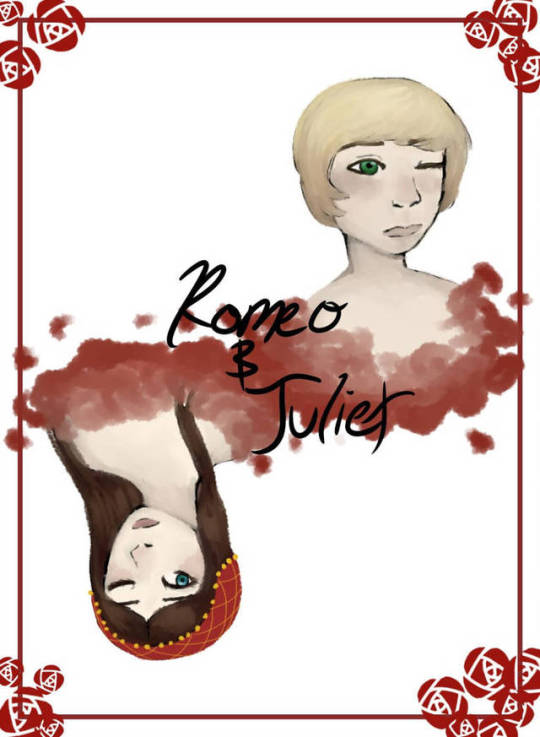
Oh man. I started drawing when I was about 10, but it was Bad. I don’t think I got much into drawing again until I was about 14? Sometime around the end of middle school/beginning of high school. I would say I started getting into drawing as more than doodling/coloring edits sometime around 2015-16? I would draw on my iPad with my finger, then I got a tablet for my computer, and now I pretty much stick to my iPad with an Apple Pencil. My first Shakespeare play was….. uh…… probably Midsummer???? I have No idea. We would go to plays when I was little, so I honestly don’t remember if I saw others before. It may have been Romeo and Juliet— I had that book where it was the original and the “modernized” with the little dog that explained things— which, if you know it makes sense, but if you don’t is probably a bonkers answer. — mod aster
Do you think this blog has like? An overarching thesis (be it b/c intentionally or simply b/c ur own take on the world has bled thru to the point where u believe it’s central to the piece at this point)? (@pedanticlecturer)
Not gonna lie, I had to read that like three times AND dm you to figure out what you were asking from us and all I have is “be gay, respect women, write your own happy endings”. — mod aster
This blog started with an ides of march shitpost and you think we have enough brain energy to write a whole thesis? I projected feelings of found family onto my half of the blog but idk if that counts. Be gay do crime 420 69 -- mod star
What’s the nature/rough dynamic of ur relationship? How do y’all know each other? (@pedanticlecturer)
Met mod aster when i was like 4 and even tho we didnt live close we became like, best friends although the Best part didnt start until we were like 13-ish and eventually we talked like non stop (about anime and homestuck. Yknow. 13 year old kid things) and we didnt see each other a lot bc of Distance and now its even worse bc aster is in colleg.,e but we consider each other siblings regardless of family bc we’re adopted into our own respective families so that bled over into our friendship and it would feel weird calling him anything other than my brother now. We’ve seen each other at our best and worst and if you really want a good insight on what we’re like as siblings watch griffin and justin mcelroy’s overview video of catlateral damage wherein i am griffin and he is the long suffering justin. -- mod star
Star is basically my long distance sibling and functionally the only cousin I recognize bc like their parents are basically an aunt and uncle and like our dads look enough alike that we’ve both accidentally gotten the wrong dad for a hug or similar so like. Anyways yeah Star is the Griffin to my Justin, complete with our absent middle brother who we love dearly— mod aster
Dubiously relevant q but what kind of music do y’all listen to when u do art (if that is indeed a habit either of u partake in) (@pedanticlecturer)
It can depend on the piece? I was working on some (unrelated) oc prints that were song-focused, and for those I just listened to said song on loop. Sometimes I have playlists. Sometimes I’ll just be in a Mood and throw a song on loop. But a lot of time for the blog, I’ll listen to The Adventure Zone for the billionth time, because I have Too Much Attention. I’ve also, on request from Star, linked the most recent “loop song”.— mod aster
I tend to obsess over the same like 3 songs every few weeks so those get listened to on repeat but it also depends on the tone of what im drawing or who im drawing i might genre switch bc of that. If im drawing ophelia i stick to lana del rey and if im drawing hamlet its the neighborhood, horatio is sufjan stevens etc. i have categorized,. Most of the characters i draw into different songs/genres/energies of music but not like i ever follow that. Sometimes i just pull up a really long nonsense video and forget to draw. Essentially: ¯\_(ツ)_/¯ -- mod star
How’d y’all come up with ur pseudonyms? (@pedanticlecturer)
I love space so much and my main blog is starryeydsailor space gay rights!! Im also tiny and full of energy and bright so basically i;m star -- mod star
Uhhhh i was like “hey i want to do uhhhhhh flower?” And then I google searched flower names until I found one I liked —- mod aster
How did you end up deciding the rough timeline of events in canon? (@pedanticlecturer)
It’s mostly determined by like. How we choose per story? If that makes sense. Like, we just take story by story, and decide “is it happening, has it happened, and when?” And then we fit them together in relation to each other just by dint of. All existing at once. Like, I knew I wanted Macbeth to be in aftermath, because like, even though there’s no murder, the way I’ve translated it to the AU is still kinda heavy, and it’s something that I don’t know that I could do properly if it were happening right now. Also, it’s more interesting IMO to have them at different times. Tl;dr we wing it per story and slot them together— mod aster (mod star agrees I just can word better, in theory)
If you could tell the story of shakespeare high in a different format than an ask blog, would you? Obviously y'all are making very good use of the format, but would you want to write this as a animated series or like? a comic book? or is the form inseparable from the story? (@pedanticlecturer)
I kinda wanted to do a webcomic or maybe to plot develop through like, animatics but the element of surprise comes from the asks we get and really makes us think so the blog is a good start. We didnt think we’d get this far -- mod star
Pretty much what Star said— there are certain elements where it’d be neat to do as a comic or as an animatic. Like, the fantasy dream is like, an anthology webcomic of each story, where you can like, see other characters in the background and stuff. But to be honest, we develop a lot by what we’re asked— there was a post about developing worldbuilding by being asked questions and then pretending you’ve thought about the answer, and it’s not far off. Personally, it’s hard to just lay out a story, because I have a whole WORLD and what’s relevant? What are people interested in? It’s by getting questions that I can then focus in on an area to develop. And yeah, we Super didn’t think we’d get this far lmao — mod aster
Any headcanons about your characters that you don't think will ever come up on the blog through asks or plot posts? (@pedanticlecturer)
I could make a whole separate post for this!!!!! Mostly its voice headcanons (and by mostly i mean like 1 or 2) or relationship hcs!!!! -- mod star
Honestly same. I don’t think I have voice headcanons for mine, though I bet I could find some. I’ve got a bunch of miscellaneous headcanons that just kinda float around, but like they’re scattered, too numerous for this post, and also not always things I’m sure are canon yet.— mod aster
#mod post#mod aster#mod star#q and a#birthday#we cant seem to read more AND tag so like brb gonna go kill god
5 notes
·
View notes
Text
Hello. It’s been awhile.. and I’m finally writing again
Hereby lies my overflowing thoughts of my journey in my 3rd year of studying composition & arranging at Lasalle College of the Arts. Hereby i present to you my logbook. I hope it’s interesting to read..
SEMESTER 1
WEEK 2 || Monday, 7th September 2020
note: Lesson 1 started at Week 2 in 2020.
Topics:
Review of Harmonic Landscape
Advanced Modulation
HARMONIC VOCABULARY
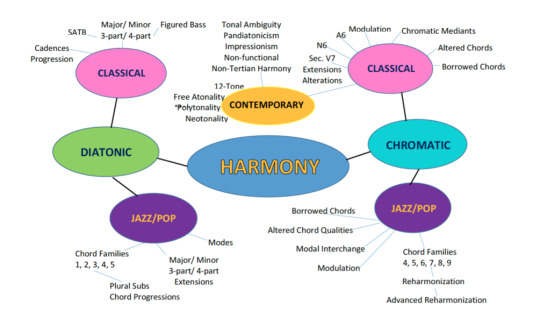
(Belinda Foo. Lasalle College of the Arts 2020)
ADVANCED MODULATION
refer to Max Reger’s text on Modulation
Some key concepts;
No Enharmonics
All modulations approached via cadence-like progressions
Observations;
The modulations are ‘logical’ and can be accountable via tonal relationships
All modulations are arrived at cadentially: IV – V – I, II – V – I, bII – Ic – V – I
It is easier to work out the modulations ‘backwards’ from the dominant of the new key
Relationships between Keys
Pivot chords
Borrowed chords
Neapolitan 6th chords (especially for remote modulations)
Dorian 6th chords (E.g. D major triad in A minor)
2nd super-dominant (E.g. D major triad in C Major)
REVIEW ADVANCED REHARM
Review Menu of Chord Choices
Using Outer Line Movement: Directional interaction between Melody and Bass line
Contrary Motion
Parallel Motion
Chromatic Movement
Tonal Movement
Tritone Movement
Pedal Point
Free Bassline
Contrary Motion

Parallelism
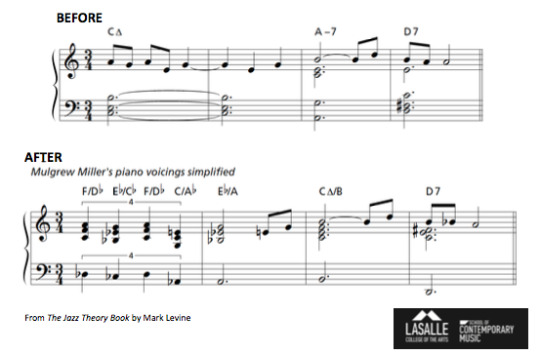
Chromatic Movement
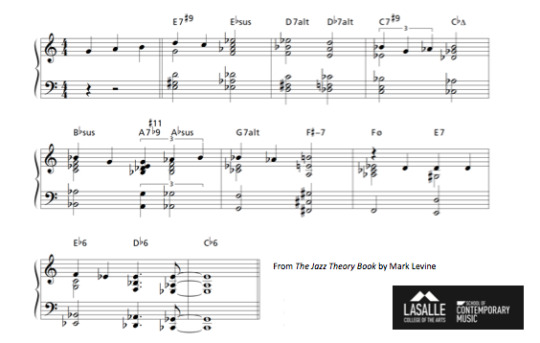
Tonal Movement
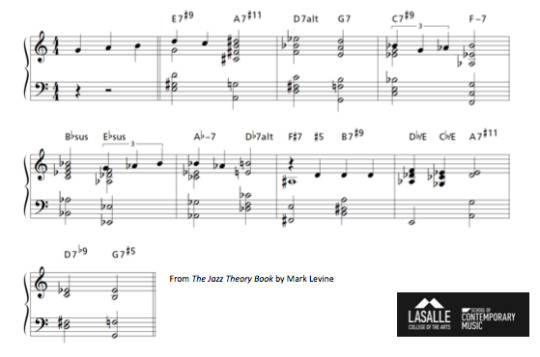
Tritone Movement
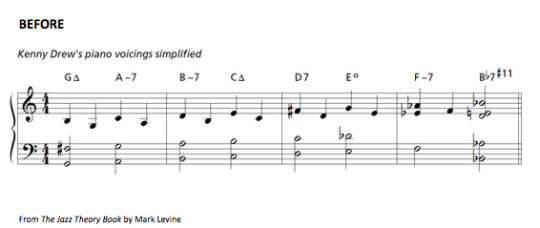
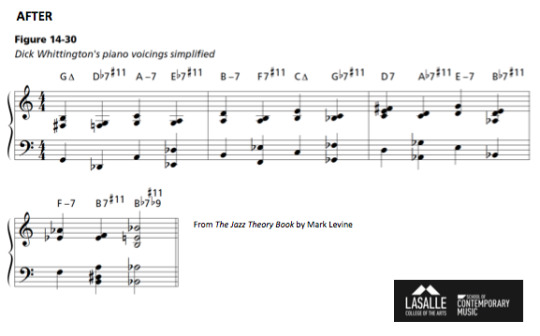
Pedal Point
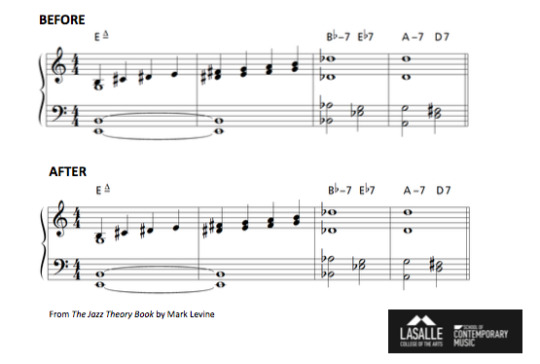
Free Bass line
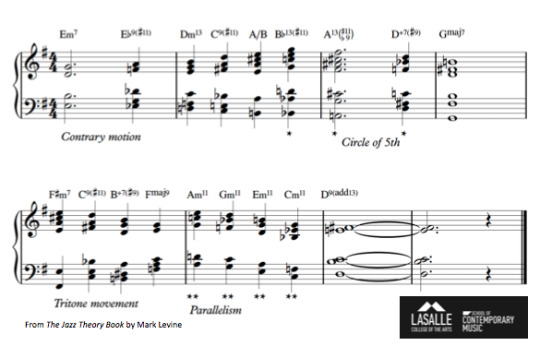
Use of Polychords
C Major triad over Bb7
F# Major triad over A7
Bb Major triad over D7
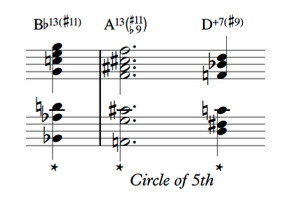
Use of Minor 11th Shapes:
Open 4th at the bottom
Triad (2nd inversion) at the top
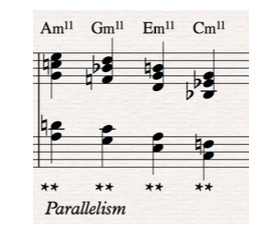
————————————————————————————— WEEK 3 || Monday, 14th September 2020
In week 2, Belinda discussed the same topics from Week 1 because we had not yet covered everything last week. My summary from this week is concluded in week 1 as it is also pretty much the same from last week. Belinda also further talked about Max Reger’s techniques.
Topics:
Review of Harmonic Landscape
Advanced Modulation
————————————————————————————— WEEK 4 || Monday, 21st September 2020
In week 3, Belinda further talked about Max Reger’s modulation again. The summary for this one is also included in my week’s 1 summary. Other than that we discussed about Romantic and Late-Romantic music, Wagner’s Lohengrin, and writing for strings.
Topics:
Max Reger Modulation Review
Romantic & Late-Romantic Orchestration
Analysis of Wagner’s Lohengrin
Writing for Strings
ROMANTIC MUSIC PERIOD
basic information:
From about 1830 to 1900
Characteristics: expressive, expansive, virtuosic, inspired by art, literature
New forms beyond the Classical forms, such as: rhapsody, arabesque, song cycle, nocturne and programmatic music
Greater Chromaticism
Extended melodic lines, themes
Romantic Composers
Berlioz, Hector
Brahms, Johanne
Bruckner, Anton
Chopin, Frédéric
Dvorák, Anton
Grieg, Edvard
Mahler, Gustav
Tchaikovsky, Peter
Strauss, Richard
Wagner, Richard
Relevance of Romantic Music Today
Melodies and Harmonies still used in Film & Animation music
Leitmotif: a theme associated with a character, place or idea
Orchestration: Romantic Orchestra & Orchestral techniques
COMPOSING FOR STRINGS
Characteristics of the Strings Family;
Homogenous timbre throughout the family
Virtually tireless for both player and listener
Flexible, versatile in terms of register and ability
Writing for Strings Masterclass:
link: https://www.youtube.com/watch?v=yST6mS8W1f8&ab_channel=JeffPifher
personal note:
This was actually a homework from previous week from Belinda, and i watched the video beforehand. There were some key takeaways to make writing for strings more interesting like (which are actually unbelievably so simple) ;
- “know what to look for” — pay attention to your melody, style, phrasing - playing with texture (e.g. one line playing staccato, another line playing legato/long lines) - accents!!! — articulation is key!!!
The Strings Choir as:
Foreground
Middleground
Background
Homophonic Writing
Accompanying Choir
Contrapuntal Textures
Special Effects and other 20th Century devices
String Section Sizes

General String Writing Tips
Divisi: divides the section, used to add/ complete harmony. Div a 2, Div a 3, Div a 4 (not common). Not a good idea to divisi violas if they are less than 8 players (6 players minimum)
Double stops: most commonly used to add harmony part. Stick to slow moving passages. Check that the double stops are feasible on the instrument.
Pizzicato: Best kept to the lower 3 strings
Octave combinations: It is common practice to double very high violin lines (Violin 1) an octave lower (Violin 2) to lend the former support.
Bowing Effects
Belinda asked us to refer to this video, which I also watched before the class as it was part of our homework from last week.
link: https://www.youtube.com/watch?v=cEBN2UkJavk&ab_channel=VIOLINLOUNGE byViolinistZlata
ANALYSE WAGNER’S LOHENGRIN PRELUDE 1
note;
during this analysis, our main focus was the string writing, string choir: homophonic writing primary line against accompaniment
link: https://www.youtube.com/watch?v=gT1AfIUgO88&ab_channel=ClassicalMusicScores
—————————————————————————————
WEEK 5 || Monday, 28th September 2020
Topics:
Max Reger Modulation Review
Writing for Woodwind
Analysis of Wagner’s Rienzi
MAX REGER MODULATION REVIEW
This week, Belinda reviewed about the Max Reger modulation. The summary is pretty much the same with the previous weeks we had it.
WRITING FOR WINDS
Characteristics of the Wind Family
Less homogenous in sound (unlike the Strings)
Single reed and double reed timbres differ
Wind players need to take breath
Some Interesting Effects
Double-tongueing/ Triple tonguing
Harmonics - The pitch of the harmonic sounds exactly as it is notated
Fluttertongue - Flautists flutter their tongues to create a “frrr,frrr” sound
personal note;
because of the lessons and workshops I had from Felix’s class (Specialized Ensemble Workshop), these effects were no strangers to me and I am quite familiar with it. I have also used these effects in my composition (mainly in his class). But this lesson was a good refresher to me.
Common Functions
Harmonic background - Homophonic wind writing
Solo passages - Choice of timbre/colours
Contrasting colors - To repeat or echo; create relief
Double other instruments - add richness, warmth; brighten up
Contrapuntal Writing
The unique color of each wind instrument makes for ideal contrapuntal writing
Refer to Britten’s The Young Person’s Guide to the Orchestra, Fugue, mm 1-55
Refer to Stravinsky’s Rite of Spring, “L’Adoration de la terre” mm 40-60.
Special Effects and other 20th Century devices
Belinda showed us some pieces that has examples of special effects. The pieces we discussed were;
1. Penderecki, Dies Irae “Apocalypsis” mm 2-4
Winds first play the highest pitch they are able to produce. Then they trill on the specified notes until the end of the dark line with arrow.
2. Stachowski, Irisation for Orchestra, third movement, mm. 79-83
The composer asks the winds to remove their mouthpieces from their instruments and “play through them.
ANALYSES OF WAGNER’S RIENZI
note:
during this analysis, our main focus was the woodwind writing, homophonic writing, choice of color,relief, highlights, adding warmth, and color
—————————————————————————————
WEEK 6 || Monday, 5th October 2020
Topics:
Writing for Brass
Analysis of Wagner: The Flying Dutchman
WRITING FOR BRASS
Characteristics of the Brass Family
Most powerful sound resource in the orchestra
Not as homogenous in sound as the strings although horns and trombones can blend fairly well
Not’ tireless’ on players and listeners — the brass sound is an imposing one and players need to breathe
Common Functions
Homophonic Unit
Pay attention to voicing, spacing, voice-leading and doubling
Refer to overtone series
Strengten and clarify harmony
Reinforcing harmony played by another choir
As a pedal
Harmonic ‘glue’, background line
State a melody
Choice of timbre, dynamics
Combinations
Double other instrument(s)
To add colour
add weight, power
Build Climaxes
Hold back first, save the colour for climactic event Contrapuntal voice
Use instruments in their best register — clarity go line and balance
Pay attention to timbral differences and articulation
refer to Stravinsky’s J.S Bach Choral Variations, Var. IV, mm. 1-6
Special Effects in Brass
refer to “Contemporary French Horn Techniques - Guide for Composers”
link(s):
https://youtu.be/_FPDrQzRE3o
https://youtu.be/-IwXEyr4uV8
https://youtu.be/qQ1oe3YSqsY
ANALYSIS OF WAGNER’S “THE FLYING DUTCHMAN”
note:
In this analysis, our main focus was the brass writing, choice of color, and orchestral combinations.
another note (not important); everytime i hear the word Flying Dutchman, it reminds me of the movie Spongebob Squarepants :))))). The Flying Dutchman is the ghost that Spongebob and citizen of bikini bottoms most feared of
—————————————————————————————
WEEK 7 || Monday, 12th October 2020
Topics:
Motivic/Thematic Development
Orchestral Devices
Analysis of Holst’s Mats, Mercury, Venus
MOTIVIC DEVELOPMENT
Repetition
Sequence
Changing intervals
Fragmentation
Extension
Inversion
Changing the rhythm
Decorated repetition
Changing order of notes
Augmentation
Diminution
Contraction
Expansion
personal note:
Belinda showed us examples (played it on her keyboard) of motivic development by playing a short motif and expand it by using the devices above. It is such a simple idea yet so useful and i foresee myself using these techniques many times because of the very little amount of time i’ll be having to write for my recital. a.k.a squeezing juice out of my brain!!!
THINKING ORCHESTRALLY
Basic Concepts
Balance
Sonority
Unity, Variety
Tone/ Timbral colour
Clarity, Brilliance
Expressiveness
Orchestral Textures
Orchestral Unison
Melody and Accompaniment
Primary and Secondary Element(s)—Melody, secondary line(s), accompaniment
Part Writing
Isolated Chords
Complex Texture
ORCHESTRAL DEVICES
String Quartet & Wind Quintet
Within Family timbres
Solo feature
Combination of timbres
Tutti unison
String devices; bowing techniques (detaché, legato, marcato, staccato, spiccato, au talon, Punta d’arco), Pizzicato, tremolo, col-legno, sul ponticello, glissandi/portamenti, harmonics
Wind devices; Double-triple tonguing, flutter tonguing, harmonics, slap-tongue
Brass devices; mutes, stopped, double-triple tonguing, glissandi, bells up (horns)
Percussion; Types of Percussion— pitched, unpitched, Metal, Wood, Non-metal, Membranous, Keyboard
ANALYSES OF HOLST’S “MARS”, “MERCURY, and “VENUS”
note;
during this analysis, we focused on the choice of color, orchestral combinations, and motivic/thematic development
personal note; i love love love uncle Holst so much. I wish i wrote his pieces. Some of his pieces from The Planets series also has become my inspirations in writing my recital pieces!
—————————————————————————————
WEEK 8 || Monday, 19th October 2020
Topics:
Review Compositional Devices
Analysis of Holst’s Mercury, Venus, Jupiter, and Uranus
COMPOSITIONAL DEVICES
remember remember remember this!
Common Practice Tonal Centers — Major and Minor
Chord Extensions — 9ths, 11ths, and alterations
Added note chords
Chromaticism and Tonal Ambiguity
Meter-Mixed and Asymmetrics Meter
Modes and other Scale sources, including Synthetic scales
Pandiatonicism
Polyharmony—Polytonality and Polychords
Non-Tertian Harmony — Quartal and Quintal
Scandal Chords — clusters
Parallelism
12-tone Technique and Serialism
Limited Composition—based on intervals
Hexachord Writing
Unrelated Triads
Neotonality
Mirror Writing
Harmonic Direction; Progression, cadential services
Harmonic Synthesis
Indeterminate Procedures
NEOTONALITY
basic information;
Tonality that is not based on any particular diatonic system nor functional harmony (Common Practice Period)
Features non-traditional concepts such as tonal assertion or contrapuntal movement around a tonal centre (which may shift).
Combining the features of Common Practice Period tonality with 20th Century tonal ambiguity and atonal characteristics
Neo-tonal Composers
Paul Hindemith
William Schuman
Roy Harris
Samuela Barber
Vaughn Williams
Sergei Prokofiev
Igor Stravinsky (Neo-Classical pieces)
ANALYSIS OF HOLST’S MERCURY, VENUS, JUPITER & URANUS
i love holst’s piece because it sounds like a film score!
Mercury
The Winged Messenger
Energetic, momentum
Changing tonalities-darting from key to key
Rhythmic & Metric ambiguity
Venus
Bringer of Peace
Woodwinds — overlapping winds, tertian harmonies, sweet
Twinkling effect — 2 harps, glockenspiel
Lines —lower strings
Jupiter
Jollity
Full of beautiful themes, melodies
Use of Timpani
Syncopation
Uranus
Rotates on its side (axis is different from other planets
‘Lop-sided feel’
Strong motif: G-Eb-A-B
personal note:
my favorite is probably the Jupiter piece. It has also become an inspiration for my recital pieces. The sounding-like-film also very much suits my style!
—————————————————————————————
WEEK 9 || Monday, 26th October 2020
Topics:
Review Compositional Devices Pt.4
NEW: Media Music
REVIEW COMPOSITIONAL DEVICES
My summary would be pretty much the same from last week
MEDIA MUSIC
basic information:
Music that is written for film, TV, animation, games, commercials, web applications with the intention of enhancing the production or product.
Practicalities to Note
Specificity of usage
Duration, mixes
Open-ended (looped), Closed-fixed duration
Style, Concept
Target Audience
Functions of music in Media
Commenting
Illustrating Movement
Enhancing Momentum
Create Atmosphere
Portray Emotions
Social/Cultural/Geographical references
Time/Period references
Connects scenes and montages
Alternate the perception of time
Imply a sense of space
Create unreal situations
Create contradictions
Physiological Conditioning
Imply size relationships
—————————————————————————————
WEEK 10 || Monday, 9th November 2020
Topics:
Serial & Atonal Counterpoint
Counterpoint in Hindemith, Bartok, and Stravinsky
Chapter 27 &28 Harold Owen, Counterpoint
SERIAL & ATONAL COUNTERPOINT
during this discussion Belinda showed us examples from;
Schoenberg, No.4 from Five Piano Pieces OP. 23
Webern, Variations for Piano Op. 27, Movement II
Things to pay attention to were;
Texture
Cohesion
Use of Dissonance & Consonance
Temporal Elements,Rhythm, Pulse, Meter
Canonic Qualities
HINDEMITH, BARTOK, AND STRAVINSKY COUNTERPOINT
Belinda showed us examples from these pieces;
Hindemith, Fuga Quarta in A, Ludus Tonalis
Bartok, Theme and Variation from Mikrokosmos, Book IV
Stravinsky, Great Chorale from L’Histoire du Soldat
we also discussed about the things noted below;
Hindemith
Compare the melodic style of hindemith’s fugue with Schoenbrg’s piece
Describe the vertical sonorities, cadences, and treatment of the major triad
Describe the temporal aspects in Hindemith’s fugue and compare them with Schoenberg and Webern
Bartok
What is the tonal centre of this piece?
Describe the melody in this example
What are the intervallic relationships?
Explain the significance of ‘Theme & Inversion’
How are the parts related and yet maintain their independence?
Discuss the rhythmic treatment
Stravinsky
How does the ‘Great Chorale’ resemble a Bach Chorale?
What key is this chorale in? Describe the cadences.
There is liberal use of chromaticism, yet the voice-leading is diatonic. Explain this.
There are triads in the harmony. Discuss how they are used here in comparison to music of the Common Practice Period.
—————————————————————————————
WEEK 11 || Monday, 16th November 2020
Topics:
Review Series & Atonal Counterpoint
Passacaglia writing
Creating Harmonic & Textural Worlds
REVIEW SERIES & ATONAL COUNTERPOINT
Discussed the same thing from last week, and Belinda discussed the things she has not yet covered, making the topic more in-depth. My summary for this is the same from last week.
PASSACAGLIA WRITING
What is Passacaglia form?
Passagcalia is a musical form of continuous variation in triple time. It was a courtly dance that originated in Spain in the 17th Century.
The passagcalia usually begins with an ostinato in the bass, but is also found in other voices.
How to write a Passacaglia?
Begin with a ’tonal’ line that will work well as a repeated pattern
Variation is created as other lines are layered over/ under this repeated pattern
This initial theme can be sequenced, but it should not be modified too much
The initial theme should always be present in at least one of the voices
Famous Passacaglias include:
Bach- Passacaglia and Fugue in C minor for Organ, BWV 582
Ravel- Piano Trio in A minor, III. Passacaille
Copland- Passagcalia for Piano (1921-22)
Hindemith- Passagcalia, Noblissima Visione Suite
William Schuman- Symphony No. 3
Things discussed;
How is the initial theme repeated, varied?
How are layers added?
How is the theme sequenced?
How are dissonances and consonances manipulated?
Observe density and contour
Observe textural changes
—————————————————————————————
WEEK 12 || Monday, 23rd November 2020
Topics:
CONSULTATION FOR HALF RECITAL
General Types of Musical Material
CONSULTATION FOR HALF RECITAL
For my consultation, I showed Belinda my first draft of my first piece from my recital, titled “The Bushfire, The Flood, and The Virus”
GENERAL TYPES OF MUSICAL MATERIAL
Unaccompanied melody
Unified harmony
Composite harmony
Imitative counterpoint
Similar Counterpoint
Contrasted Counterpoint
Composite musical material
Unaccompanied Melody
Solo
Doubled Unison
Doubled at the Octave(s)
Tutti Unison
Unified Harmony
All parts move in the same rhythm
May be minor, incidental rhythmic differences
Uniform tone-quality
example;
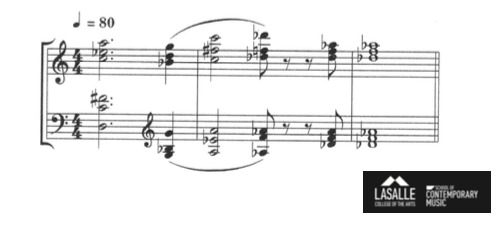
with some minor, incidental rhythmic differences;
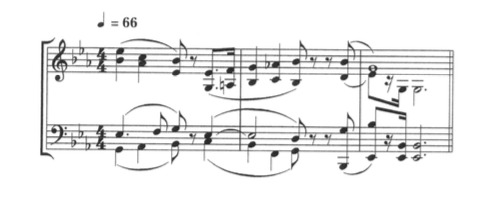
Composite Harmony
2 or more chordal components are layered, each harmonically completely alone
May be treated as harmonically unified or composite
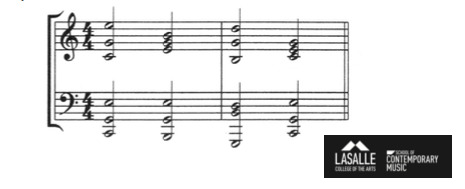
a large vertical distance between the 2 shapes divides it into 2 parts. The harmonic effect is divisive.
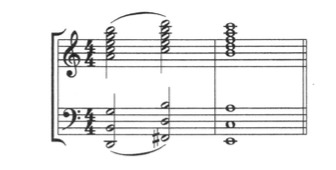
The contrary motion of 2 simultaneous chordal units: produces the effect 2 constituent harmonic units
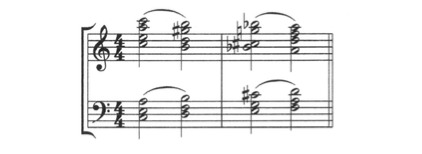
The presence of 2 or more chordal units, with independent rhythms

The effect of unified or divisive harmony depends on these factors:
Tone-quality: the use of a single tone-quality or similar tone-qualities will produce a unified effect
Direction: parallel movements tend to be more unifying than contrary motion
Common rhythms are unifying
Large distances between harmonic units have a divisive effect
Imitative Counterpoint
This involves canonic situations.
To bring out the relationship of imitative parts, one tone-quality should be used.
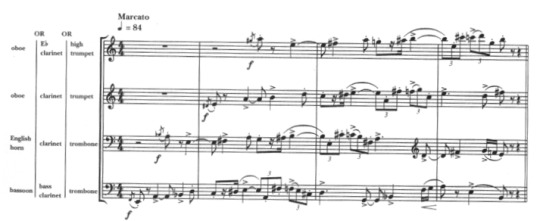
‘Similar’ Counterpoint
This is non-canonic counterpoint.
The parts are related by common rhythmic and intervallic ingredients
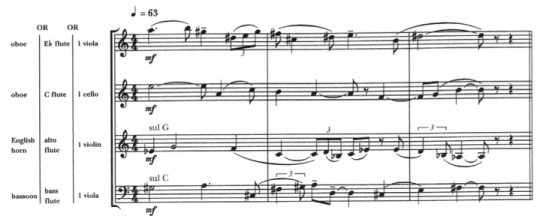
Contrasted Counterpoint
The lines are have noticeable differences in intervals and rhythms
The differences may be accentuated with the use of different timbres

Composite Music Material
A melody with its own rhythm, accompanied by unified harmony in another rhythm, plus composite harmonic interjections:
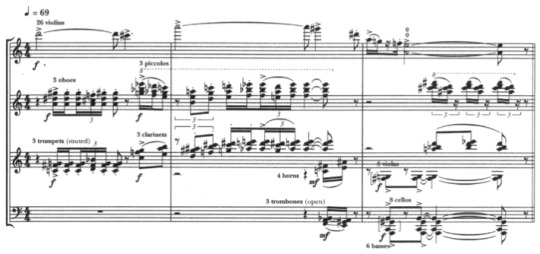
next example; Imitative counterpoint (piccolo & clarinet) superimposed on unified harmony (strings) in contrasted rhythm, plus a bass line (tuba) in a different rhythm.
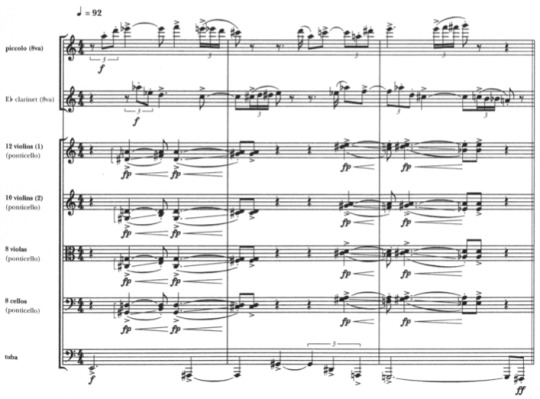
Next example: Composite harmony- violins & violas in 1st group, cellos & basses in 2nd group- enclosing a 2-part ‘similar’counterpoint (2 horns), whose rhythm is different from the harmony.
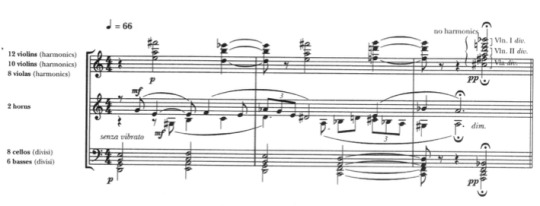
—————————————————————————————
HALF RECITAL
for my Half recital, i submitted 3 pieces out of 4. They were the;
The Bushfire, The Flood, and The Virus (2′20″)
Purple Pinkish Cotton Candy Sky (1′57″)
Full Moon (2′32″)
———————————————————————————
———————————————————————————
———————————————————————————
SEMESTER 2
WEEK 1 || Monday, 18th of January 2021
Topics:
Review semester 1
Scoring for Film, Animation, and Media
Review Semester 1
It was finally the first day of school again! at the beginning of the class, Belinda asked about what we had been doing during the holiday. I personally spent my holiday working on writing 3 shanghai jazz songs for a short film. In addition, I was arranging for lasalle’s Composer’s Concert 2021. Planning the date, concept, musicians (for my own band), and composers who are interested to showcase their pieces at the concert. —— BACK TO THE TOPIC —— Belinda mentioned that she was surprised to hear some of the works from half recital which me and my classmates did and we were happy to hear that! afterwards, the lesson started.
Scoring for Film, Animation, and Media
Finally....SCORING. One of my biggest interest in music is Film Scores. And to be honest with you, the reason i went to Lasalle and took Composition & Arranging as my stream was because i wanted to be a Film Composer. I’ve always dreamed of being one ever since i was young. So, this topic really interest me indeed. I had been looking forward for Belinda to teach this ever since the start of my day 1 studying at lasalle. “Finally... i thought.”
Here are a little summary from it;
Film Scoring — The People
The Producer: responsible for developing and nurturing the project from beginning to end. He hires the proper people, raises money, seems the film. His role is varied and straddles the administrative, financial, and creative.
The Director: responsible for envisioning and approving creative decisions. He wants the score to reflect and enhance the idea of what the film is about.
The Executive Producer: Usually the CEO of the production company. He is not in charge of the daily processes but will exercise final control over all the elements—business and creative.
The Editor: works with the director and cuts, edits his footage into a story flow. He is likely to have a good idea of how the music should fit the footage and can be an excellent liaison between composer and director
The Music Supervisor: handles the administrative part (and sometimes creative) of the music for the film/ TV program. He works with budgets, negotiated deals, hires contractors, arranges recording sessions, etc.
Film Scoring — The Screening
Go in with a notepad
Concentrate on the big picture—the overall emotional effect, the film’s effectiveness
First impressions matter—note them
Get a sense of the mood, feeling
Do not do any spotting yet
Film Scoring — Rough Cut
Establish a concept for the score
Demonstrate that concept the composer
Whilst helpful in providing the composer with a clear musical direction, they can also be a bane when the director is so used to the music that anything else will not satisfy him
Film Scoring — Style & Genre
In every style, genre of film, there is an appropriate response, an expectation, a vocabulary. These expectations are based on a precedent, a thorough study of classic films in a particular genre is essential to successful scoring. It’s not about imitation but about knowing the language and eliciting an appropriate response/reaction.
Film Scoring — Main Genres
Action
Adventure
Animation
Comedy
Crime & Gangster
Drama
Epic/Historical
Fantasy
Horror
Musicals/Dance
Science Fiction (Sci-Fi)
War
Westerns
Film Scoring — The Concept
The concept is the heart of the score. It can be discussed in terms of musical style and will form the basis of the thematic material of the film score. The composers needs to understand the central character and motivations.
There is also another dimension to scoring the character apart from scoring his/her personality, and that is, getting inside the character’s head. That dimension can chance from scene to scene, moment to moment.
On my personal note; i went to surf the internet and read more about this. After reading more about film music, i discovered that film theorists often categorize film music as diegetic or non-diegetic. Diegetic music, the music we perceive the characters can hear, is part of the story world. Meanwhile, Non-Diegetic, also called as commentary or nonliteral sound, is any sounds that does not originate from within the film’s world. Non-Diegetic music (such as a film’s title theme) narrates the film from “outside” the story world and is only audible to the audience. When Belinda mentioned about the music getting inside the character’s head, it can also be referred as diegetic music.
Back to the topic, to summarize, when talking about the concept of the film, it’s important for us the composer to know what the film is really about. Explore the characters and their themes. Often, films will have more than one dramatic theme; a personal theme and a larger overview sort of theme.
another thing to take note is that musical genres/styles are often part of a score and it is IMPORTANT to stay CONSISTENT to those styles throughout the film. Composite style (where several different stylistic elements are fused together) are also permissible but think of the appropriateness of the music to fit what is happening on the screen.
Film Scoring — The Tone
Tone refers to the attitude of the dramatic work. Whether is it dark or uplifting, etc. The composer needs to get a clear direction of tone in order to ‘assist in the storytelling’.
example: “Raiders of the Lost Ark” is a movie whose tone changes drastically from moment to moment: from humor to terror, from impending doom to a swashbuckling escape.
Checklist:
Overall dramatic theme
The central character
other themes
Time (period) / Place / Ethnic flavor
Instrumental Palette
Musical Style
Combination of styles, colors?
personal side note:
Perhaps what i understood about this is that the tone of the music is something that everything revolves around with, and in order to set the tone of the music, we need to understand the concept of the film well enough. Understanding the character, mood, and genre.
The tone can be set by things like our orchestration, instrumentation color palette (timbre), and also the techniques we use to compose like harmonic language and texture.
—————————————————————————————
WEEK 2 || Monday, 25th of January 2021
In week 2, Belinda resumed the topics from week 1. She also discussed more deeply about it. In this week, she also talked about the devices/musical techniques that we should considerate when scoring for a film.
Topics:
Scoring for Film, Animation, and Media (Part 2)
FILM SCORING — ETHNIC, PERIOD
When scoring for films with ethnic/period character, the composer needs to decide if he/she will score totally in that style, just flavored by those musical elements or not influenced by that time and place and all.
In some instances, musicological accuracy is necessary, but most situations call for a combination-approach: ethnic/historical accuracy and other harmonic/melodic language to score the drama and action.
Things to consider:
The film’s point of view
Scales, motifs, folk tunes, harmonies of that ethnicity/ time/ place
Rhythms of that ethnicity/ time / place
Instruments
There us a fine line between authenticity and stating the obvious. Avoid music clichés and other tires and overused references.
FILM SCORING — PLAYING THE DRAMA
Your audience has expectations: as a composer, you need to know what they are before you can use those expectations as tools for manipulation.
You can surprise your audience, but never betray them. Their expectations are tied closely to the function of the score and the style of the movie. The score must do what the audience expects it to do- excite them, lift them up, tug at their heart strings, make them curious, etc.
The composer knows the ending but the audience doesn’t, so it’s really important that the music never “spoils” it or gives too much away.
Whose point of view are you playing? The audience or the character?
If you are playing the audience’s POV, you’re scoring their emotional reaction. If you’re playing the character, then you’re scoring the emotional/ mental state or action that the character is in or is doing.
Main Title: The main title establishes the overall tone and setting for the movie and primes the audience’s expectations.
Dialogue: Underscoring dialogue is tricky as the composer needs to ensure that the dialogue can always be heard and understood. Where the lips can be seen, comprehensibility is easier as the audience can lip read. In instances where the lips cannot be seen, extra care needs to be exercised.
notes on Dialogue:
In general, smooth musical textures are less intrusive. Also, try to keep out of the speaking range.
Stay away from accents and distinct solo lines: allow the spoken line to be the ‘soloist’
Don’t overwrite. It’s an underscore.
MUSIC AND ITS ASSOCIATIONS
Many styles of music already have their visual and emotional associations: Gritty Jazz puts us in a big city, Gregorian chant brings us into a monastery. Use the power of musical associations to get the audience in the right place, in the right state.
for example: the film “Out of Africa” scored by John Barry has the genre of classic romance. The score is associated to the romance rather than about the period film set in Africa.
Musical Points of View
Getting inside the character
De-emphasizing the scene
Juxtaposition—playing against the scene
The minimalist approach (ex: “American Beauty” plastic bag scene by Thomas Newman
Silence
Highlighting, accenting the drama
MUSICAL CONSIDERATIONS
Now that you have a concept for the score, the next step is to translate that concept into musical terms.
The basic elements to consider are melody, harmony, rhythm, and instrumental color.
Unity and Variety
Strong scores strike a fine balance between repetition (recognition) and variety. Repetition in music can help to develop emotional power through the cumulative reactions of the audience to the repetition of a theme. With repetition, the association between the music and the characters/ situation becomes stronger.
The same theme can also be modified/ varied to suit a different setting.
Tempo/Pulse
This is the first task of the composer: to determine the pace of the scene/cue
Checklist:
Does the tempo feel emotionally compatible with the scene?
Does it provide forward motion?
Will it provide too much forward motion?
Is this a comfortable tempo for dialogue?
If the cue calls for tension, play a low repeated note with basic pulse and check if there is dramatic build-up
There are cues/scenes that require a change in pulse and tempo. The composer will need to plot a variable click in those instances.
Hitting/Catching the action
Unless the composer is scoring for cartoon/ animation, he/she will not be catching all the action. This is also known as Mickey-mousing.
The average score catches less and more subtly and often plays through the scene. Composers will score the emotional shifts in the scene, usually subtly, through entry of themes, change in colour, rhythm etc...
Composers need to analyze the scene by taking note of the shifts of emotional emphasis, shifts in action, shifts in camera angles, editorial cuts.
Beginning the Sketch:
Plot out the shifts on your sequence. Note the timings
Decide on the tempo and tempo changes. Plot the click and adjust meters accordingly.
Compose the thematic material for the cue.
Plot it into the sequence. (It may not appear at the beginning of the cue)
Check to see if the entry of the theme is compatible with the visual and shift it/ adjust it until it fits.
Write around the theme- into its entry and after it is stated.
Using the 4 basic elements of melody, harmony, rhythm and instrumental colour, finish writing the cue.
The motif is a powerful compositional tool that composers have used throughout the centuries. The motif allows the composer to write with unity and leaves him/her room for variety.
A strong motif is the key to a strong score.
Examples of strings motifs;
Beethoven’s 5th Symphony
John William’s Jaws
John Barry James Bond- Octopussy
Nino Rota Godfather- Love Theme
John Williams- Return of the Jedi- Darth Vader Theme
Bill Conti- Rocky Fanfare
HARMONIC CONSIDERATIONS
Harmonic language is the emotional palette that composers use to elicit a desired response from the audience.
Triadic shapes and traditional progressions elicit different emotions from atonal and dissonant sources. Composers need to pay attention to the tension or placidity of their harmonic choices and combinations.
Choices:
Diatonic Harmony and Chromatic Harmony
Modal Harmony
Pandiatonicism
Quartal/ Quintal harmony
Exotic/ Synthesized scales
Limited Composition, Hexachords
Polytonality
Atonality/ Serialism
Harmonic Devices:
Vertical Structures (Homophony)
Linear writing (contrapuntal writing)
Pedal points
Ostinato
Complex Texture
—————————————————————————————
WEEK 3 || Monday, 1st of February 2021
Topics:
Influence of Great Composers
17 Functions of Music in Film
INFLUENCE OF GREAT COMPOSERS
In week 3, Belinda showed us some of the most influential composers in the past that also affects film composers nowadays. Some of the composers and their pieces she discussed in the class were;
Stravinsky - “Rite of Spring”
Bartok - “Music for String instruments, Percussion and Celesta”
Orff - “Carmina Burana”
Brahms - ”Symphony No. 3, 3rd movement”
In the class we discussed and analysed about the musical devices that are happening in the pieces. like;
The melodies, lines, motives and identity, motivic development
The harmonies, harmonic devices; harmonic language as an emotional device
Rhythmic devices; rhythm as a thematic idea, uneven meter, polyrhythms
Orchestral devices; orchestration as a tool for characterization/setting, orchestration as an emotional device.
17 FUNCTIONS OF MUSIC IN FILM
1. Commenting
This is a function that shouldn’t be overdone. Music can put a judgement on certain movie scenes, it can state that a certain battle scene is heroic, a certain dialogue is sad etc.
In the early days of film music, the function of the music was most of the time to comment on the images. Nowadays we perceive this as an annoying redundancy most of the time but used cleverly it will help push the audience into the right direction.
2. Illustrating Movement
Another function that feels rather old fashioned and comedy. Accenting with the music every movement seen on screen is so-called mickey-mousing (coming from a scoring technique that was often used in Mickey Mouse cartoons). Hearing xylophone “plings” when someone raises his eyebrow etc. feels very cartoony however it can be great in slapstick moments and when done well even in dramatic situations.
3. Creating Plot Relationships
The use of so-called leitmotifs has been established by Richard Wagner in the opera and has often be used in film context since the early days of film music. Giving certain characters/situations/places thematic identities helps to connect certain plot points together.
When the villain gets a theme and later we hear that theme again when somebody talks about a “stranger” we get a very clear hint of who that stranger might be. It doesn’t need to be that obvious for leitmotifs to work, of course. However, be warned to not overdo that technique. Not every supporting role needs a motif/theme and it can quickly feel very old fashioned when using this method extensively.
4. Creating Atmosphere
This is one of the strongest function of music in the movies. It can set the tone of the movie. Just by the way the score comes in for the first time in the movie makes it possible to know the genre and the “level of drama” of the movie. Of course exactly this really strong function can be used to create plot twists.
5. Portray Emotions
Another very strong function. Music can serve the movie by getting into the emotions of the characters. A face with a neutral expression can be pushed into “feeling” many different things just by what kind of music is used. In the same way it works of course very well to evoke certain emotions with the audience.
6. Social/Cultural/Geographical references
Music can work very well to make clear the heritage of a character/group of characters or the geographic setting of the movie or a scene. Often so-called pseudo authenticity is used that uses music that feels like a certain location to western ears as opposed to actual music that can be heard at that location (which differs quite heavily sometimes).
If for example Irish sounding music can be heard during a certain scene etc. we can easily spot where it’s taking place without the need of visually establishing the location too much.
7. Time/Period references
Music can also work very well to establish a certain time or period. Music that sounds very baroque will put us back into the 18th century but references can also be more subtle. Flashbacks over a few decades for for example can be very well supported by the musical style which adapts to the time portrayed in the movie and therefore makes the flashbacks more understandable.
8. Connects scenes, montages
Music helps very well to glue scenes together. Rather harsh scene changes can be softened by adding music over the scene change. One of the extremes of these forms are montages which work beautiful with music. Even though we might have a lot of jumps in time/places or even periods, when the montage is covered under one score cue it will at the same time be glued together and understood as a whole.
9. Manipulate
One of the functions of music that is and has been used quite a lot, even though it is not one of the most noble functions of music. Doubtful contents of a movie can be pushed into the “right” direction by music as it has been seen with lots of propaganda movies from all periods of times. However it can also be used very cleverly. For example when a character that is being portrayed as “the good guy” but actually is the villain.
However in this case this fact will only be revealed at the end of the movie. Any moment before where the audience might get trapped into maybe thinking that he might be the evil guy, the music can jump in and manipulate in the way of working against these doubts.
10. Alternate the Perception of Time
The perception of time is a fantastic playground for music. Just by altering the tempo of music, it can heavily push or drag any scene. Imagine a chase sequence where the music pushed with lots of tempo, exciting orchestration etc. compared to the same sequence with a calm, slow music. The latter one would almost feel like it’s real but it would make the scene way less exciting. Same goes for any time perception. A scene where we see a person waiting which lasts only 30 seconds can be extended painfully in the perception by the music.
11. Imply a sense of space
Not only the perception of time but also the perception of space can be influenced by the music. Using a very intimate piano+violin duo on a space science fiction movie might seem just as wrong as using a full symphony orchestra in a two character movie that’s taking place in a small flat. Also by the use of register (very deep sub bass or very high violin notes as opposed to music that plays mainly in the middle registers) can leave an impression of “size”.
12. Creating unreal situations
Characterizing nightmares or situations of shock or being paralyzed can be done perfectly by the music. Anything that gives the feeling of not being real can be greatly enhanced by the music. Nightmares of characters can be made much more impressive with the right music.
13. Creating Contradictions
Music that sounds like something that is not expected in a certain scene will create a feeling of “something is not right”. It works great for example on dialogues that are actually neutral from the content of what is being said. However having a really dark and sinister music under this scene will leave the impression that something will be happening, something might be wrong here.
14. Parody
Music can influence very strongly whether we find a scene to be serious or laughable. It can use this ability to create fantastic parodies of characters or situations in the movie. One very simple example would be a character who pretends to be very evil and acts like this, however the music just gives him/her a quirky wannabe-evil march.
15. Physiological Conditioning
Music can also influence and stimulate our very basic emotions like fear and therefore evoke in a best case scenario every physiological consequence that comes with that emotion like racing heart, sweaty hands etc. Especially in the genre of horror and thriller, these effects are used extensively. A certain level of volume will make it impossible for the body and the conscious mind to detach from these emotions.
16. Implying Size Relationships
A little boy walking alone through a huge city is just a scene that might be very suitable for this use of film music. In this case the music can enlarge the visual differences between these things by giving the boy a little innocent flute motif on top of a very low, boiling music which might symbolize the huge city. In this way, things that can’t be seen like that on the screen can be set into relationship.
If this little innocent boy from above might actually be a really brave, heroic person who has done or is about to do big things the music might set him into another “size” dimension to the city even though the images don’t reveal that yet.
17. Psychologically Uniting The Audience
One of the most obvious case of such a function of music are national anthems whose function of course also is, to unite the “nation”. The same works in the music. Especially euphoric, heroic emotions can be used very effectively to get this collective emotion. Often, well known songs/music pieces can be used for that as they are easier accessible than music that the audience hears for the first time.
However, even a very heroic score cue on top of a scene where the heroes of the movie walk through a crowd applauding a cheering at them after they fought the last big battle and won can create exactly this collective feeling of having been part of all that also with the audience.
———————————————————————————
WEEK 4 || Monday, 8th of February 2021
In week 4, Belinda delve deeper into the topic she discussed briefly in week 2 about musical considerations.
Topics:
continuity from week 2—
Musical Considerations
Melodic & Harmonic Considerations
Rhythmic Considerations
Orchestral Considerations
Scoring Examples
When discussing about HARMONIC CONSIDERATIONS, Belinda showed us some examples of good scores, like;
John Williams: Star Wars- The War Reel 1 Part 3
E.T.- The Departure
Jerry Goldsmith: The Omen- The Demise of Mrs Baylock [Youtube- The Omen Pt 8, 1:05]
The Omen- Ave Satani
Michael Small: Star Chamber- Main Title
and when discussing about RHYTHMIC CONSIDERATIONS, she showed us a reference from
Omen- Altar of Sacrifice
Hans Zimmer- Man of Steel (Drums sessions) and Oil Rig, Tornado
The first reference is to showed that rhythm can be a powerful thematic idea on its own. Rhythmic ostinatos are often employed to provide drive and forward motion. Whereas the second reference showed that the percussion section can bring into the score its own color, texture, dynamics, and emotion.
things to note:
Composers should explore asymmetric meters for variety or when the cue calls for a less even rhythmic pattern.
Aleatoric rhythms (improvised) may also be explored as long as the emotional/ dramatic direction of the cue is clearly indicated to the musicians.
ORCHESRAL CONSIDERATIONS
Orchestral colour is a powerful emotional tool. After answering the initial questions: What kind of music does this need? What tempo is this?
The next most important question is: What kind of sound does this need?
Belinda discussed about the how the size of an ensembleand how it affects the sound and the mood. She also gives reference of different scores with contrasting orchestration palette. some of them were;
Vangelis- Chariots of Fire
Daft Punk- Tron Legacy (Mixed- electronic and
Orchestral)
Trent Reznor (Nine Inch Nails) & Atticus Ross- The Social Network
things to take note:
A change in orchestral colour will cause an emotional/ dramatic shift.
A theme can take on different meanings with different orchestration treatments.
Apart from typical idiomatic colours, there are also special effects and extended techniques that can be employed today to inject drama and emotion in new and fresh ways.
The best way to learn how to orchestrate is to study orchestral scores of the Masters, especially the scores of the Romantic and Late romantic composers.
Pay attention to their use of colour, balance, weight, span, sonority, transparency and other orchestral devices.
———————————————————————————————————
Week 5 || Monday, 15th of February 2021
First of all, i was excited for the lesson by seeing the topics list that Belinda showed before the class. Because Neoclassicism has always been apart of my writing style and i draw a great amount of inspirations from the Neoclassicism composers, especially William Schuman. Although Belinda has taught us in Year 2 about this and mentioned it quite a few times, but it was a very good refresher to learn about this again and listened to her explaining about it.
Topics:
Neoclassicism
Score Analyses:
- Stravinsky: Symphony in C - Hindemith: Mathis der Maler - Schuman - Symphony No.3
NEOCLASSICISM
basic Information:
A return to ‘Classicism’- to clarity, order, balance, economy, and emotional
restraint.
A reaction to the emotional excesses of Romanticism and dissonance of atonal 20th Century musical movement.
Emphasis on form, rhythm, contrapuntal texture, updated/ expanded harmony
Started between the 2 world wars- 1923 to1950
Composers & Works
Pulcinella — Stravinsky
Symphony in C — Stravinsky
Mathis der Maler — Hindemith
Appalachian Spring — Aaron Copland
Symphony No.5 — Prokofiev
Symphony No.3 — Roy Harris
Symphony No.3 — William Schuman
Menu of Compositional Devices
Common Practice Tonal Centres — Major and Minor
Chord Extensions — 9ths, 11ths, 13ths, and alterations
Added note chords
Chromaticism and Tonal Ambiguity
Meter-Mixed and Asymmetric Meter
Modes and other scale sources, including Synthetic scales
Polyharmony— polytonality and polychords
Non-tertian Harmony — Quartal and Quintal
Scandal Chords — clusters
Parallelism
12-tone Technique and Serialism
Limited Composition — based on intervals
Hexachord Writing
Unrelated Triads
Mirror Writing
Harmonic Direction — progression, cadential devices
Harmonic Synthesis
Indeterminate Procedures
Noise, Sound, and Electronic devices
Extended Techniques
Texture
Microtones
SCORE ANALYSIS
my thought:
I loved the examples that Belinda showed. But my favorite would be Roy Harris’s Symphony No.3. Belinda showed us this technique called “micropolyphony” or actually complex texture. There’s this section from the piece at timecode 7:00 (in youtube) where Harris used the micropolyphony and it sounded beautiful. Although every part plays different notes, but the section just sounded beautifully because their parts shared the same pitch classes. After learning about this technique, I straightly have an idea to use it in one of my recital pieces “The Rain and The Rainbow”. To feature it in the Rain part.
———————————————————————————————————
WEEK 6 || Monday, 22nd of February 2021
This week, Belinda taught us the importance of analysis and how you can benefit greatly from it. I totally agree with the idea of analysis. Whenever i writing something, usually i would always draw and idea from a music that i like. After listening to the music, usually i would transcribe the section that i like then i always learn something from it. In a way i also analyzed it. Even though only in a small chunk, but i benefit so much from it.
Topics:
Analyses: What are you looking for? What are you looking at?
Texture & Timbres
WHY ANALYSE
You’ve heard of the phrase/ method, “reading to write”, which refers to the practice of reading for the purpose of becoming a good writer.
There is an equivalent in music, and that is, analysing scores for the purpose of becoming a better composer.
We begin by developing the habit of listening to good music, and allowing the music to open our ears to good compositional and orchestral devices.
We learn/ imbibe a lot through ‘osmosis’, through a process of immersion. If we immerse ourselves in good music, some of that inspired style and musical eloquence may just seep into our subconscious.
With the score, we then apply analytical skills to better understand how the parts work together to make up the beautiful whole.
A good method for analysis is the ‘Funnel Method’- by starting with the big ideas, broad strokes first, then working through the piece with greater specificity and detail.
A good place to start is the concept of the composition, the purpose or intention for the piece.
Form and structure would be the next logical parameter for analysis: sectional form, phrasal structure and transitions.
Thematic analysis, primary and secondary materials, development and variation would be next.
Texture and Density would follow.
Orchestration, timbre, orchestral devices should be examined.
Rhythm, Meter, Articulation and other devices associated with movement, momentum should be examined.
At all times, dynamics and emotional contour should be observed and all the elements mentioned above taken into consideration.
Don’t forget to ‘pull back’ and take note of the balance of unity and contrast in the composition.
How does the composer achieve cohesion in this piece?
Is the piece comprehensible? If so, how does the composer achieve this comprehensibility?
Annotate, annotate, annotate.
Take note of first impressions and latter impressions.
Compare your analyses with others, share and compare notes.
Listen to various recordings/ conductors you can glean different things from different interpretations
Make a note or make sketches of ideas you can ‘borrow’
TEXTURE & TIMBRES
Texture is the combinations of pitch, timbre, and rhythm
Common categorization of texture: Homophony, Polyphony & Complex
Considerations:
Harmonic/scalar language
Density
Intervallic Relationships
Belinda showed us examples of different textures from different pieces. My favorite of the Micropolyphony examplewould still be in Roy Harris’ Symphony No.3 (timecode 7:00 on youtube).
—————————————————————————————WEEK 7 || Monday, 1st of March 2021
Topics:
Debrief — Composers Concert
Character, Mood, and Emotion
DEBRIEF — COMPOSERS CONCERT
Belinda talked about what went well and not from our Composers Concert 2021.
notes:
As of my piece “Mrs. Puss” that was performed, Belinda told me that the Violin in the piece was quite soft whereas it supposed to be louder since it played some lead lines. I agreed to that, however it wasn’t because of the playing, but was because of the sound that was coming out from the speaker that the audience heard. To me (as the musician who also played together in the band), the Violin sounded okay from my perspective. I was hoping that that they will adjust that in the mixing post-production.
Khushi and Matt also had the same issue with the balancing. But really it was more of the mixing.
Another issue that they were facing was muddiness.
As of the other pieces (string quartet), Belinda referred many of it to be not-so cohesive and comprehensible. and that is one of the key takeaway that we can learn from. The solution lies in the composer himself actually.
Belinda told us that when a piece is cohesive and comprehensible, you won’t notice it, but when it is not then you’ll notice that. I understood what she meant and that’s what i also felt like when hearing the pieces for the first time in the google drive that was shared to me.
A few miscommunication between me and my other peers. Can be improved.
Otherwise, it was a quite successful show. Now just waiting for the release date!!!
regarding the issues that we had (compositionally), Belinda gave us notes about a few things which we can learn and apply it when we’re writing for our pieces for our final recital;
FOCUS & DIRECTION
Intentionality
Focal line(s), focal sound?
Unity (the constant) vs Contrat (variation) beyond the structural, the vamp, the progression. Where are you taking the listener?
Emotional Contour — shape and climax(es)
Pace—maintaining and building momentum
ARTICULATION, DYNAMICS, AND EXECUTION
Ensemble playing & hits:
Accents — the long & short of it
Communication & Tightness
Contrast hits with flow, unison with open voicings
Tight with dynamics, play with changing dynamics
Contrat quick passage with space and breath
regarding communication and tightness, Belinda also critique about my band’s articulation. She told me that my double bassist in the band (Eugene) seemed to be the only who gave the correct articulation whereas the others are too focused in playing the right notes. I mean, playing the right notes is crucial, but afterwards you should learn how to enjoy the song. Honestly, i head bopping and trying to enjoy the piece too, but i guess its true that i was still too afraid to play wrong notes and my gestures was too small. And i guess hm my head bopping was some sort of....hmm..how should i say it.. only gimmick? and perhaps that showed too.
VERTICALS & SONORITY
Pay attention to register- close intervals at lower registers will sound muddy
If the verticals are ‘hot’, it will sound muddier!
Use polytonality with intention & caution. Control dissonances, voice appropriately.
Combine familiar shapes (e.g. triads & quartals) to construct polyharmonies
FORM
The most complex of compositions can be comprehended if FORM is apparent
Pay attention to constructing clear sections (that flow/ transition cohesively)
Pay attention to building & developing motives/ themes: maintaining unity, yet creating diversity/ contrast
important questions:
What am i saying?
How am i saying it?
Finally, Belinda linked it to the lesson——————
CHARACTER, MOOD, AND EMOTION
Music and extra-musical associations
Clarity of expression
Tools:
Melodic line(s)
Harmony/ Verticals
Texture
Orchestral color & devices
All about sound:
The overtones series-consonances and dissonances
Melodic and motivic ideas: steps, skips, and leaps
Intervallic tendencies
Melodic Shape and Contour
Phrasing, Cadences, and Breath
Primary, Subsidiary
Harmonic Language—
Tonality (poly, neo)
Atonality, Key/Mode Colours
Chord/Vertical Colours
Rhythm—
Pulse, Tempo, Natural rhythms
Momentum
Duple/Triple and Asymmetric Meter
Subdivisions, Triplets
Orchestration—
Orchestral Colors
Orchestral Devices
Orchestral Elements and Texture
Form and Structure—
Organization
Development
Sense of Unity
Recognition, Logic, Cohesion, Comprehensibility
FINAL RECITAL
finally Belinda briefly talked about our Final Recital and some checklists;
String Quartet
Wind Quartet: Flute, Oboe, Clarinet, Bassoon
Optional: laptop playback
Possible Combinations:
Full ensemble + Laptop playback
String Quartet
Featured Wind(s) with Strings Quartet
Featured String with Wind ensemble
—————————————————————————————WEEK 8 || Monday, 8th of March 2021
NO LESSON.
—————————————————————————————
WEEK 9 || Monday, 15th of March 2021
Topics:
Key Centers/tonal Centres
Shifting Tonalities
Neotonality
KEY CENTRES
There are many degrees of key center gravity or keylessness
Apart from chordal progression, melodic direction, repetition of notes and instrumentation can suggest/emphasize tonality
MODULATION
The concept of Modulation is based on the relatedness of any chord to any of the 12 tonal centers.
‘Traditional modulations’ are based on pivotal chords.
‘Less traditional modulations’ may be abrupt parallel shifts or based on looser pivots, such as pivot notes and then softened by voice-leading.
POLYTONALITY
Be careful that the combined effect does not produce a haphazard sound. The music must be conceived in polytonal context and not sound accidental.
The composer needs to work this in a ‘total organization’ framework, paying attention to tonal planes.
The Harmonic total must have a sense of direction, flow, tension design and textural consistency.
Use spacing, register, texture and omission to create clarity and avoid muddiness.
examples of displaced tonality;
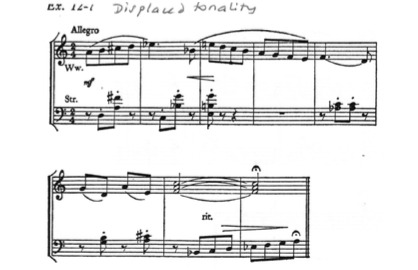
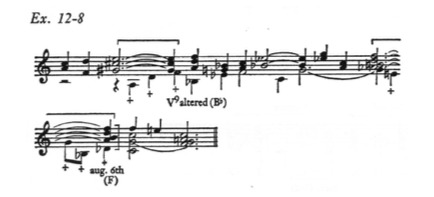
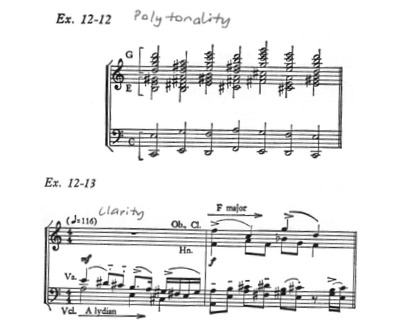
SERIAL HARMONY
The choice of notes in Serial Harmony are either dependent on the row (Total Organization) or include endless possibilities if the method of serial composition is less strict.
Intervallic relationships: consonances and dissonances are important factors in deciding how verticals are formed.
Melodic direction, voice-leading and texture also determine the overall effect of sonorities.
Motivic/ thematic features support cohesion and comprehensibility.
Rhythmic features and articulation are prominent characteristics.
examples of serial harmony;
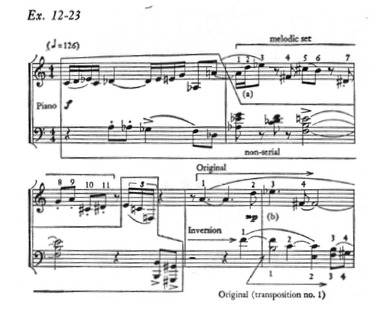
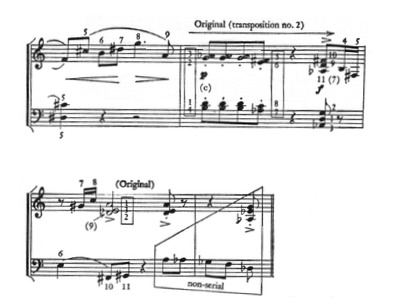
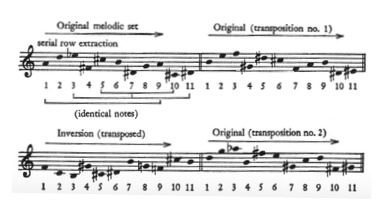
NEOTONALITY
Tonality that is not based on any particular diatonic system nor functional harmony (Common Practice Period)
Features non-traditional concepts such as tonal assertion or contrapuntal movement around a tonal centre (which may shift).
Combining the features of Common Practice Period tonality with 20th Century tonal ambiguity and atonal characteristics
Neotonal Composers
Stravinsky
Bartok
Kodaly
Janacek (maleva likes him)
Vaughn Williams
Prokovief
Shostakovich
Hindemith (maleva likes him too)
Samuel Barber
Villa-Lobos
Ginastera
William Schuman (MALEVA’S FAVORITE)
Roy Harris
William Walton
personal note:
on my personal note, i listen to these composers during my free time. and i found my pieces that really interest me. Some even has become my own personal “temp track” for my recital pieces! for example; Janacek’s “The Cunning Little Vixen: II. Allegro” was my inspiration when writing my piece “Purple-Pinkish Cotton Candy Sky” and “Full Moon”. Other than Janacek, I also took great inspiration from pieces from William Schuman, and others! Don't believe me?? Look at my SPOTIFY PLAYLIST!!! i legitly made playlists for each of the pieces that i want to write. I collect pieces that inspires me the most and built my creativity based on that.
maleva’s playlists for “Purple Pinkish Cotton Candy Sky”;
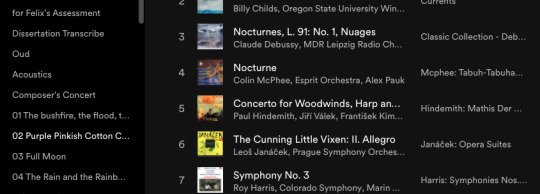
maleva’s playlists for “Full Moon”
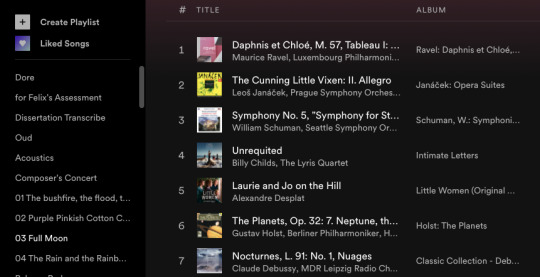
BACK TO THE LESSON;
at the end of the class, Belinda finalised the instruments that we will be having for our recital and remind us again regarding some checklists.
—————————————————————————————
WEEK 10 || Monday, 22nd of March 2021
This week’s class was so interesting, as we dissected the piece of our own BELINDA titled JOB
Topics:
Deconstructing JOB — A Symphonic Dance
Thinking timbrally
JOB — A SYMPHONIC DANCE
form
narrative driven
Dance form
“Through-composed”
Thematic thread
sections in order;
Parade of the Celestials
Gigue of the Adversary
The Challenge
Sabean Attack
Chaldean Attack
The Wind-Collapse-The Sores-Job’s Wife’s Curse
Sitting in Silence
Duet (Dialogue 1)
Dialogue2
Dialogue 3
The Whirlwind
My Eyes Sees Thee
Repent and Retract
Coda-Allegretto
THINKING TIMBRALLY
Wind Quintet & String Quartet configurations
Woodwind
Individual characteristics-flutey, reedy, hollow
Combines timbres
Dove-tailing
Spacing
Register and Dynamics
Harmonic balance
Unison and Doublings
Strings
Individual characteristics
Spacing
Harmonic balance
Register and Dynamics
Unison and Doublings
Combinations
Timbral combinations
Oboe & Cello
Bassoon & Cello
Flute and French Horn
Solo Wind with Strings
Solo Strings with Wind Ensemble
Contrapuntal, mul-timbral applications
Textures: harmonic textures, contrapuntal streams
Percussion & Miscellaneous
Definite and Indefinite pitch writing
Accents, shimmer, highlights, weight
As a features instrument
Orchestration Principles
Balance: feature, main, secondary...
Dynamic and emotional contour
Clarity
Span, register
Weight, Float
Interest
Momentum
Readability
—————————————————————————————
WEEK 11 || Monday, 29th of March 2021
Topics:
Review Form
Analyze Stravinsky’s Babel
Analyze Schwanter’s Aftertones of Infinity
FORM
Binary Form: A B
Ternary Form: A1 B A2
Sonata Form;
Exposition: 1st Subject/ Transition/ 2nd Subject/ Codetta
Development
Recapitulation: 1st Subject/ Transition/ 2nd Subject/ Coda
Simple Rondo Form: A1 B A2 C A3
Rondo-Sonata Form
Exposition: 1st Subject/ Transition/ 2nd Subject/ 1st Subject
Development
Recapitulation: 1st Subject/ Transition/ 2nd Subject/ 1st Subject/ Coda
Theme and Variation: featuring a main theme followed by altered iterations
Passacaglia: A series of variations over a basso ostinato
STRAVINSKY — BABEL
texture and density
Ostinato
Verticals
Chorale treatment
Narrative-Form
Momentum and Motion
SCHWANTER — AFTERTONES OF INFINITY
** i think this piece is amazing. Belinda also mentioned that this piece won a Nobel prize! there were a few things to take note of like;
Shimmering musical timbres
Layers of Sound
Protoset: C#-A-F-Gb-C-B-Ab-Eb-D
Predominant intervals
can be watched from here;
https://www.youtube.com/watch?v=Sns6KLvrb_o
—————————————————————————————
WEEK 12 || Monday, 5th of April 2021
Topics:
Review Compositional Devices
Analyze Toru Takemitsu’s A Flock Descends into a Pentogonal Garden
COMPOSITIONAL DEVICES
Common Practice Tonal Centers- Major and Minor
Chord Extensions- 9ths, 11ths, 13ths and alterations
Added note chords
Chromaticism and Tonal Ambiguity
Meter- Mixed and Asymmetric Meter
Modes and other Scale sources, including Synthetic scales
Polyharmony- polytonality and polychords
Non-tertian Harmony- Quartal and Quintal
Secundal Chords- clusters
Parallelism
12-tone Technique and Serialism
Limited Composition- based on intervals
Hexachord Writing
Unrelated Triads
Mirror Writing
Harmonic Direction- progression, cadential devices
Harmonic Synthesis
Indeterminate Procedures
Noise, Sound & Electronic devices
Extended Techniques
Texture
Microtones
TORU TAKEMITSU
Belinda mentioned how amazing that Takemitsu — although his music is very modern, but he would always never lose his Japanese touches in his music. Belinda also mentioned us about the importance of having a signature sound in our music. And it’s good if we can feature our own identity like where we come from for example.
Takemitsu’s music:
Straddled “parallel music cultures.”
Bi-musicality in modern Japanese culture: mixture of Western music with traditional Japanese music
In this piece, he uses the pentatonic scale (called the yo scale in Japanese.)
TORU TAKEMITSU — A FLOCK DESCENDS INTO A PENTOGONAL GARDEN
Clustered verticals
Silvery glisses
Lyrical melodies
Metallic, bell-like textures
Pentatonic base: C#- Eb- F#- Ab- Bb
Belinda also showed us some examples of some Contemporary String Quartets pieces;
String Quartet No. 2, "musica instrumentalis": III. Double Triple Gigue Fugue- by Aaron Jay Kernis, performed by Jasper String Quartet
link: https://www.youtube.com/watch?v=Y1dxsWGrtzQ
String Quartet No. 1, Op. 8: IV. Fugue- by Alan Hovhaness, performed by Shanghai Quartet
link: https://www.youtube.com/watch?v=VTQmztjK_2g
Love letters for String Quartet by Carter Pann, performed by Ying Quartet
link: https://www.youtube.com/watch?v=ER0faKEz0Ss
my personal note;
The “Love Letters” by Carter Pann was my personal favorite and i even listened back to it after the class ended.
—————————————————————————————
WEEK 13 to WEEK 16
throughout these weeks we had no more lessons but more consultation for our final recital.
0 notes